




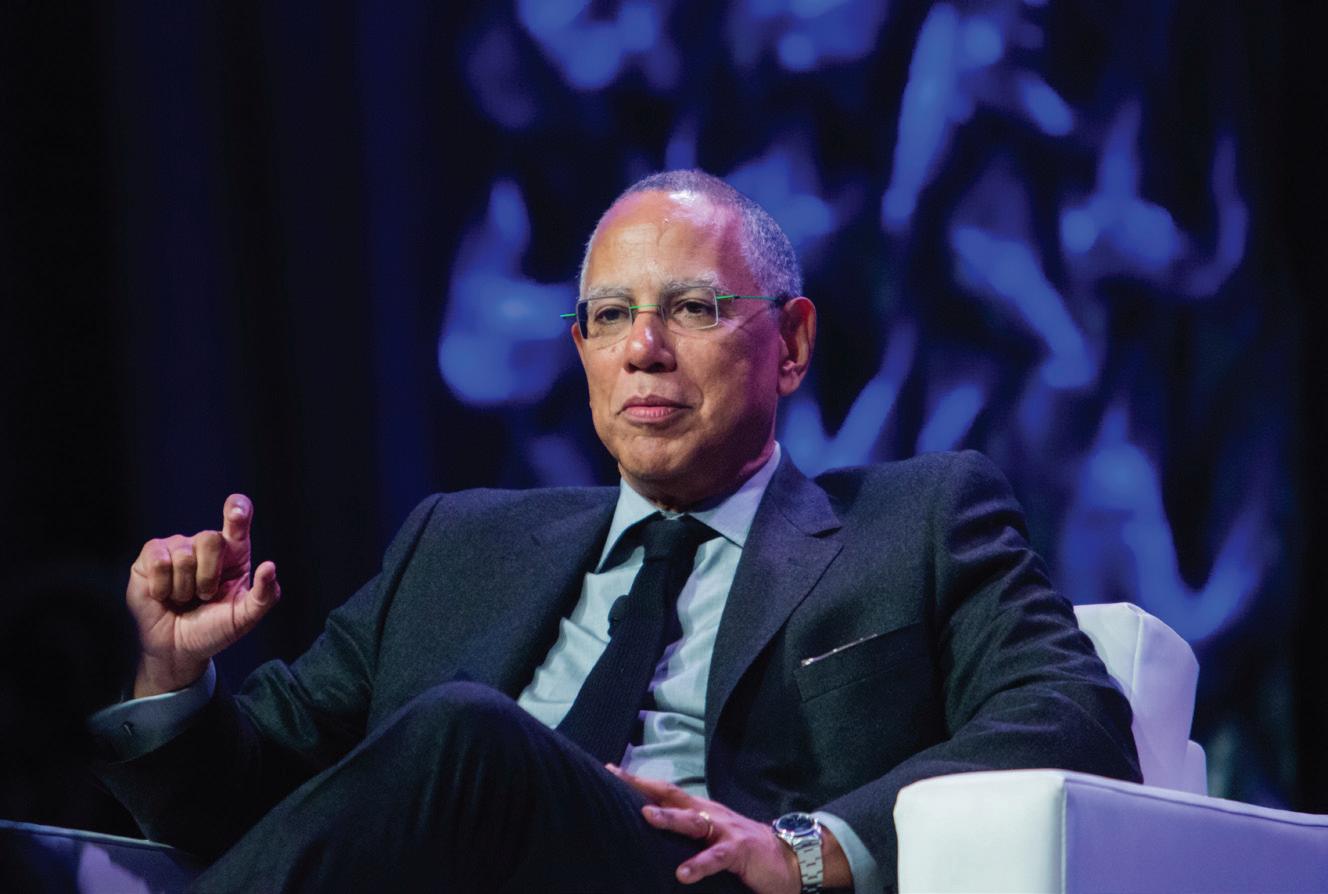
■ On Tuesday, the Brandeis Journalism Department hosted former New York Times Executive Editor and Pulitzer Prize recipient Dean Baquet.
On Tuesday, March 4, the Brandeis Journalism Department invited former New York Times Executive Editor and Pulitzer Prize recipient Dean Baquet to serve as keynote speaker for the 2025 Elaine Wong Distinguished Lecture Program. Baquet formerly served as the executive editor for the Los Angeles Times and made history as the first African American Executive Editor of the New York Times. He spoke about the interplay between the media and polarization in a discussion moderated by Associate Professor of the Practice of Journalism Ann Silvio (JOUR) and adjunct lecturer Adriana Lacy (JOUR), as well as Professor Paul Anskat (SOC).
The event, which took place in the Rapaporte Treasure Hall, was packed with professors, students, alumni and prominent journalists from the Boston Globe, The New York Times, Boston University Radio and many more. Audience members who couldn’t grab a seat stood in the back or sat along the sides in order to witness the discussion.
The forum began with opening remarks from the University’s Interim President, Arthur Levine ’70. He shared that “journalism … is going to be one of the most powerful forces we have for helping us maintain our democratic society.” He drew upon the role of journalism in United States history to frame the discussion, mentioning Woodward and Bernstein, the reporters who exposed the Watergate scandal.
The conversation began with a response to the recent news that Jeff Bezos, who bought The Washington Post in 2013, has decided that its editorial page will be advocating for personal liberties and free markets. The newspaper will not be publishing opposing viewpoints moving forward. Baquet stated that “We know that we’re going to need an avid debate about everything, from tariffs to, I suspect, the First Amendment. I don’t think this is the time for one of the major leading news organizations to narrow that discussion.” He further shared his concerns for The Washington Post’s journalistic integrity, “[Jeff Bezos] is a very unusual publisher, and he has wide interests, and it looks to me that he’s put the interests of those wider interests, from his space program to Amazon itself, ahead of the newspaper.” He elaborated,
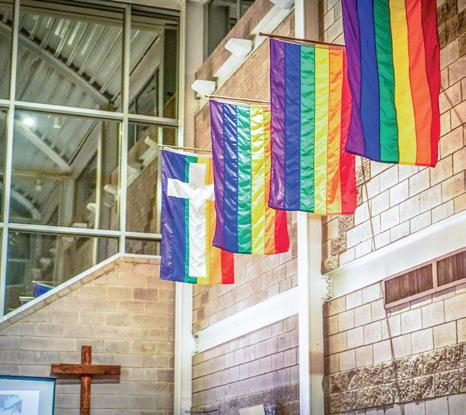
“I don’t think it’s great for democracy that the greatest American news organizations have very narrow slices in the audience, and that includes The New York Times and The Washington Post … It’s another attempt at a solution to a really powerful problem. It’s the fact that he did it just before the election.”
Baquet subsequently spoke on the difficulty of striking a balance between maintaining journalistic principles, financial responsibilities and the need to expand audiences. “One of the hardest things about leading institutional change is … to really try to figure out what’s our core and what are the things that really matter? If that list is too long, you’re not going to change.” He gave an example, “The way we wrote news stories in the print era … is not a natural way to write. We were all forced to write the pyramid style … we were forced to do it. And it became such a part of our [ that if you poll journalists, they actually said ‘this is who we are’. It actually isn’t who we are … so I think you gotta make sure that the things you’re fighting for are actually the things you’re about.” Baquet pointed out “of course, editorial integrity is among them.”
The discussion then shifted to cover journalism during President Donald Trump’s 2015 election campaign. Baquet discussed some methods employed by The New York Times to protect the integrity of the media, and elaborated on how Trump fundamentally altered the journalistic landscape. “One reason that news organizations are struggling with an issue of trust is that a guy who has … controlled anywhere from 30-45% of the American vote constantly, day in and day out, beats us up … we’re not very good at defending ourselves.” He recognized some shortcomings of The New York Times in protecting their media from delegitimization, “[Trump] would attack us and we would … stand with our stories. That’s not good enough anymore. If I had to do it over again, when he started attacking specific stories, I think I would have set up a way to defend them.”
Baquet described the Times’ effort to become more transparent since then, “It used to be, we published a story and we didn’t tell you how we did the story … we didn’t tell you anything about the reporter’s background.” Baquet reflected on the changing nature of the field of journalism, “When I was in [Journalism] school, we were always taught not to be a part of the story and to kind of not really be visible. But now, we’re sort of doing quite the opposite, having them, you know, on Instagram … and very visible.”
When questioned about coverage of Trump and the election, Baquet remarked that “Frankly. I actually think the press, the mainstream press, did a really good job covering this election … I think it was tough,
■ The Brandeis Library Union rallied on Wednesday as they continue contract negotiations with the University.
By LIN LIN HUTCHINSON JUSTICE EDITOR
“Wrap it up” was the prevailing chant among Brandeis University library union staff, students and other Uuniversity employees during a March 5 rally. Around 30 attendees gathered outside the BernsteinMarcus Administration Center to express their continued support for the library union, which has now been in contract negotiations for eight months. The union is seeking safeguards to protect its employee’s’ future as it claims the University seeks to contract out work “without any restrictions.” Additionally, they are seeking a contract that prioritizes salary adjustments that account for inflation and the rising cost of living in the Greater Boston Area. The March 5 rally aimed to add pressure onto the administration. The previous contract, originally expiring in June 2024, has been extended multiple times while the union’s bargaining unit and the University work toward an agreement on fair terms. While the union acknowledges some progress since its Jan. 23 rally — particularly in discussions around its demand for structured pay increases over time — it remains concerned about the university’s approach to outsourcing union work.
“We can't allow the University to contract out our work,” said Alexis Cooper, a member of the bargaining unit for the union in an opening statement to attendees. Cooper added “Our work is union work. If that work is no longer union work, then there's no need for us to keep the Union workers around.”
Also present in support were members of Service Employees International Union 888’s newly formed university staff union that represents administrative, technical and academic staff. Rebecca Strauss, an art technician at Brandeis and member of the new union, expressed gratitude for the library union and other on-campus unions, as they were “instrumental” in the formation of the staff union, a process that be-
gan in October of 2024. Her presence at the rally was both a gesture of appreciation and a commitment to strengthening the solidarity between unions. She was also motivated to attend to demonstrate her appreciation for the role the library plays in the University’s function, as it goes beyond housing and lending books by serving as a hub for research, academic support and providing creative resources like the Digital Scholarship Lab and MakerLab.
“I'm here because it's right,” said the ninth-year employee. “It is right for workers to demand respect, equitable pay and protections of the work. Those of us who work in higher [education] and in academia are not here because it’s gonna pay us a million bucks. We're here because we're passionate about it and we want to use our skills and expertise to support the mission of higher education.”
Students of the Brandeis Jewish Bund were also present at the rally. A member of the student group spoke on the issue of respect as it relates to the Uuniversity’s reputation.
“I think we all want Brandeis to be a respectable institution. We all go here. We all utilize Brandeis. We all came to Brandeis for a reason,” the student of Brandeis Jewish Bund said. “If Brandeis cannot pay its employees a living wage then that's not respectable, and they can't be respectable if they choose to outsource work that should be available for qualified people who are working here already.”
The student noted that while the University has come to the bargaining table in good faith, it is not enough to address workers’ concerns. “They're really not asking the Administration to rake the moon when it comes to salary or anything else.”
As of the rally, union organizers said the University has offered a 2.25% salary increase but remains concerned about the rise of inflation and cost of living. According to the Consumer Price Index, the inflation in the Boston-Cambridge-Newton area is currently around 3.9%. The union's petition claims that several library workers earn below the minimum of Brandeis’s own hiring range for their positions, with over 89% earning below the median. The petition has received 400 signatures according to the union. Concluding the rally, organizers called for the University to live by its motto “Truth, even unto its innermost parts.” The union was scheduled to convene at the bargaining table the next day, on March 6.
■ The faculty discussed the University’s potential reorganization plan and voted on possible amendments to it during their March 7 meeting.
By SOPHIA DE LISI JUSTICE DEPUTY EDITOR
On March 7, faculty members held a meeting in the Rapaporte Treasure Hall to further discuss the University reorganization plan that the Senior Associate for Faculty Affairs, Prof. Joel Christensen ’01 (CLAS), introduced during the faculty’s Feb. 28 special meeting. The meeting agenda included memorial minutes for Prof. Arthur Holmberg (THA) and researcher Robert Dunigan as well as an address from Interim President Arthur Levine ’70.
The Chair of the Faculty Senate, Prof. Jeffrey Lenowitz (HIST), started the meeting by reviewing the minutes from the Feb. 7 and Feb. 28 meetings. There were no corrections raised, and Lenowitz declared the meeting minutes approved.
Prof. Dmitry Troyanovsky ’98 (THA) spoke in memory of Holmberg, recalling that he met him 39 years ago as an undergraduate at the University. He said that Holmberg inspired him to become a professional theater director and educator, saying that Holmberg praised his strengths, but never held back his criticism when Troyranovsky’s work was lacking. Holmberg’s approach to teaching didn’t only apply to theater, but prepared students for life, he said.
Prof. Sharon Reif Ph.D ’02 (HELLER) delivered Robert Dunigan’s memorial speech. She shared that Dunigan was the first in his family to attend college and encouraged many family members to follow in his example. As a Black man with a Ph.D, Dunigan was part of “a very small group,” and aware of the importance of giving back. Reif said he was a mentor to many Black and Latinx students at the Heller School

MIKEY TERRENZI
for Social Policy and Management and worked closely with his colleagues to start an anti-racism group. A moment of silence followed both of these memorial speeches, and Levine started his address. He said that while memorials are deeply sad, they also give him “extraordinary insight” into the work that faculty members do in the community. He started his address by thanking the faculty members for attending these meetings and town halls, “but most of all, for imagining a better Brandeis — a better future for Brandeis.” He thanked Christensen for designing and leading this process, and the Board of Trustees for giving the University a year without budget cuts, allowing time to launch a capital campaign along with “other remedies.”
Levine urged the attendees to support the reorganization plan for a number of reasons, saying that “we can’t remain where we are” as we’ll move towards mediocrity if we don’t act.” He explained that changes in the economy and in Washington D.C. will see one-fifth of colleges close with increasing numbers of universities becoming “online degree programs.” He thinks this reorganization plan will strengthen the University by giving faculty the chance to re-imagine general education and create a program that better reflects its mission.
“[The reorganization plan] really carries out what you told me you wanted, which is to remain an R1, a liberal arts college,” Levine said. He added that this reorganization plan responds directly to the needs of the Brandeis community, rather than allowing administration to continue letting time pass while deliberating the best course of action. Levine said that this plan also appeals to students and parents because it prioritizes internships, career preparation, microcredentials and transcripts. He said that the reorganization plan will also make Brandeis more unique, and a pioneer in higher education.
“The result is going to be an onslaught of media [coverage],” Levine said. “But the real reason we need to do this is to generate revenue.” He added that the plan gives the University a chance to do something that it has needed to for a long time, to specifically
Student Union Vice President Ria Escamilla-Gil ’27 called the March 9 Senate meeting to order. Attendees heard an announcement from President of the Student Union Rani Balakrishna ’25, processed committee reports and heard a budget proposal for an event.
Balakrishna started the meeting with a couple of announcements. She discussed Deis Impact, which is taking place between March 10 and March 12 and encouraged senators to attend workshops and engage. As Balakrishna is graduating this year, she is planning on passing down her knowledge as best she can to support the new Student Union. Balakrishna also reminded senators that elections are coming up and that they will be the final elections of the year.
The senate read their executive order reports and finance reports before committee chairs gave reports. First, the senate heard from Executive Senator Daniel Shin ’27, the head of
Medical Emergency
Feb. 28—A party reported being shocked by their charger and feeling disoriented. The patient refused further medical treatment.
Mar. 1—There was a medical emergency for a party who fell and hurt their eye. The patient was transported to a local hospital for further treatment.
Mar. 2—There was a medical call for a party who reported having stomach cramps. They were treated by BEMCo. The patient refused further medical treatment.
Mar. 2—There was a medical call for a party with a cut on their hand. The patient refused further medical treatment.
Mar. 2—There was a medical emergency reported for a party who had collapsed. They were treated and refused further medical care.
Mar. 2—There was a medical emergency reported for a party who fainted. They were treated by BEMCo and refused further
the Club Support Committee. Shin discussed the possibility of changing requirements for probationary club presentations but didn’t discuss specifics as it is still in the works.
Next, Jake Rosen ’27, the head of the Campus Life Committee discussed its recent efforts in coordinating a meeting time with Harvest Table. He also presented a proposal for some materials for an upcoming open mic night. The event was coordinated with Chief of Staff Allie Ladjeva ’27. The proposal was expedited and then passed by a vote of acclamation.
The Senate then heard from Sarah Jafary ’28, the head of the Health and Wellness committee, which is in the process of purchasing a Narcan vending machine that is going to be placed in the Shapiro Campus Center. The committee is considering hosting another self-care day, as it is midterm season.
The Senate heard from Lukas Gordon ’26, the head of the Internal Operations committee. Shin and Gordon met with the
Department of Student Engagement Director Michelle Puls to discuss how students should approach inter-club conflicts. If students are unable to reach a conclusion themselves they should reach out to the Student Union for support unless it is a huge issue that the University should handle.
During the last Senate meeting Gordon proposed a new and revised mission statement for the Student Union. At this meeting they reviewed the statement. After minor changes the statement was passed by a vote of acclamation from the senate. Finally, Gordon briefly went over the process of changing the bylaws of the Student Union. The Executive Branch has been working on editing the bylaws and making them up to date. They plan to be completely finished and make them available to the public as soon as possible.
— Kelsey Stevens
medical treatment.
Mar. 2—There was a medical emergency reported by a party with a severe headache and abdominal pain. They were treated by BEMCo and refused further medical treatment.
Mar. 2—There was a medical emergency reported for a party with a hyperextended knee. They were treated by BEMCo and transported to a local hospital.
Mar. 3—There was a medical emergency reported for a party who fainted. They were treated by BEMCo and transported to a local hospital.
Mar. 3—There was a medical call for a party with a cut on their finger. The patient refused further medical treatment.
Mar. 3—There was a medical call for a party with left arm pain. The patient refused further medical treatment.
Mar. 4—There was a medical emergency reported for a party experiencing a panic attack. They were treated by BEMCo and refused further treatment.
Miscellaneous
Feb. 28—There was a suspicious phone call originating from New York City.
Mar. 1—There was a vehicle stopped on Charles River Road. All appeared normal.
Mar. 1—A party reported a set of poker chips missing, possibly stolen.
Mar. 2—Two phone calls were made by a party and then hung up with what sounded like party noise in the background. The Area Coordinator on call was notified.
Mar. 3—A party reported damage to a room and there was minor damage to a wall, possibly from a pool cue.
Mar. 5—A party went to the police station concerning a previous case.

■ A news article incorrectly spelled a name as “Harber.” It was corrected to “Haber” (March 4, Page 1).
■ A news article incorrectly spelled a name as “Roshash.” It was corrected to “Rosbash” (March 4, Page 1).
■ A news article incorrectly a put a photo caption as “ANDREW BAXTER/The Justice file pphotos photos” It was corrected to “ANDREW BAXTER/The Justice file photos.”
■ The arts section incorrectly published a Sudoku puzzle that was impossible to solve. It has been taken down (March 4, Page 16).
The Justice welcomes submissions for errors that warrant correction or clarification. Send an email to editor@thejustice.org

■ Dr. Mo Seyedsayamdost ’01 leads a laboratory at Princeton University that is working to uncover potentially life-saving antibiotics.
By ANNA MARTIN JUSTICE EDITOR IN CHIEF
The transformative power of a Brandeis education extends into the world of enzymology, as demonstrated by Dr. Mo Seyedsayamdost ’01, whose groundbreaking research is uncovering potentially lifesaving antibiotics. Before earning his PhD at the Massachusetts Institute of Technology, Seyedsayamdost embarked on his journey of scientific discovery at Brandeis University, where he immersed himself in research under the mentorship of Prof. Liz Hedstrom (BIO/CHEM).
In a March 5 exchange with The Justice, Seyedsayamdost reflected on his formative years in Hedstrom’s laboratory, where he worked for a year and a half and co-authored several publications as an undergraduate. He credited Hedstrom’s intellectual precision and insatiable curiosity as profound inspirations. “I was inspired by her rigor as well as her inquisitive mindset,” he shared on March 5. In a separate interview with Brandeis Magazine, he painted a vivid picture of his dedication, recalling, “I would do my homework in Hedstrom’s lab … I would eat there. I would do experiments there. It was a refuge, just such a beautiful world in and of itself.”
Beyond his work with Hedstrom, Seyedsayamdost found inspiration in other esteemed members of the Brandeis science faculty. He highlighted former Professor Melissa Moore (BIOL), a key contributor to the development of the Moderna
COVID-19 vaccine, and Prof. Daniel Oprian (BIO) as influential figures in his academic path. Moore’s Introduction to Biochemistry course “unlocked my passion for the subject; it made me switch from a pre-med track to research in biochemistry,” he explained.
Seyedsayamdost thrived within Brandeis’ Biochemistry department, describing it as “a mecca for enzymology, and an analytical and deep mechanistic mindset, which was a foundation of the biochemistry department, is something I learned and applied throughout my scientific work.” Today, he serves as a professor of chemistry and molecular biology at Princeton University, where he also mentors students and leads pioneering research in antibiotic discovery.
The majority of commercial antibiotics — used to treat infections ranging from pneumonia to syphilis — originate from molecules produced by a handful of microbial genera. To date, only a few hundred such molecules have been identified. However, microbial life is capable of generating thousands more molecules, most of which remain unexplored.
Seyedsayamdost’s lab is at the forefront of efforts to uncover these elusive antibiotics, an endeavor that has become increasingly urgent due to the alarming rise of antibiotic-resistant bacteria. Over the past two decades, common microbial strains have developed immunity to widely used drugs, complicating treatment efforts. According to the Centers for Disease Control and Prevention, antibiotic-resistant infections afflict approximately 2.9 million people annually in the United States, leading to at least 48,000 deaths.
His lab operates at the cutting edge of antibiotic discovery, leveraging the remarkable efficiency of naturally occurring molecules. Seyedsayamdost explained, “All these traits that chemists work hard to code into synthetic drugs are sometimes just there in naturally produced molecules, because it’s their evolutionary purpose.” Evolution has fine-tuned these molecules over millions of years to perform highly specific
biological functions, such as targeting chemical receptors, permeating cell membranes or inhibiting critical enzymes, often with greater efficacy than human-designed compounds.
To harness this potential, Seyedsayamdost’s team has developed an innovative screening methodology known as HighThroughput Elicitor Screening. This approach involves cultivating microbial species on laboratory plates, stimulating them to secrete bioactive compounds and rapidly analyzing the resulting chemical structures and biological properties. The efficacy of this methodology has been remarkable — his team has identified over a thousand novel compounds, a feat that earned Seyedsayamdost a MacArthur “Genius” grant in 2020.
One of his lab’s most promising discoveries emerged in 2023: keratinicyclin B, a molecule produced by certain soil bacteria with the potential to combat Clostridium difficile, a notoriously drug-resistant pathogen. Unlike conventional antibiotics that often disrupt beneficial gut flora, keratinicyclin B selectively targets C. diff. It attacks the cell wall with precision, sparing commensal microbes. This breakthrough holds significant promise for addressing a formidable clinical challenge. Looking ahead, Seyedsayamdost envisions expanding his research beyond antibiotics to explore other classes of bioactive compounds, including antioxidants, anticancer agents and bacterial signaling molecules. He is particularly interested in harnessing these signaling compounds to manipulate bacterial behavior within the human microbiome. Seyedsayamdost will mobilize beneficial bacteria to preemptively eliminate pathogens before infections take hold. “Harnessing these latter substances … may one day allow us to intentionally control how bacteria in our bodies behave.” Seyedsayamdost speculated further, “maybe in the future, we won’t have to use antibiotics at all … Maybe we can figure out how to trigger our own microbiome to produce these antibiotic molecules themselves.”
■ Superintendent Mendonsa shares updates on district literacy, while plans for the Facilities Department’s move are tabled as the district waits for funding.
By LIN LIN HUTCHINSON JUSTICE EDITOR
District-wide literacy accomplishments, kindergarten registration, Dual Language School lottery and the potential relocation of the Facilities Department were among the topics discussed at the March 5 Waltham Public School Committee meeting.
In her update, Waltham Public Schools Superintendent Marisa Mendonsa shared that the district sent less “dyslexia letters,” this year then last.The letter acts as notification to guardians of “at-risk” students who may be showing signs of potential dyslexia based on in-class observations and provide recommendation further evaluation to determine if the child needs accommodations or additional support. Mendonsa said last year, 500 letters were distributed, but this year the number dropped by 17% down to 414. She added that while
literacy levels in kindergarten through fourth grade showed consistency or improvement, fifth-grade students continued to face literacy challenges, largely due to the ongoing impact of the COVID-19 pandemic, during a critical stage of their education.
During her presentation, Mendonsa reminded the committee and families that kindergarten registration is open for the class of 2038 and that families interested in the Dual Language School lottery are to submit all required paperwork by May 1, for the scheduled May 2 lottery.
Mendonsa introduced a discussion about the potential relocation of the Waltham Public Schools’ Facilities Department. For the past six months, the former Waltham High School on Lexington Street has been under consideration as the new home for the facilities department. Administrator of Facilities Stephen Jelloe presented a tentative four-phase relocation plan, estimated to cost $181,500. However, funding for the project has yet to be secured.
Currently, the district’s facilities department is located at 258 Trapelo Road. The available space at the old high school, formerly used for Career Training and Education, became vacant following the opening of the new Waltham High School this past fall. The plan to relocate involves multiple steps, beginning with clearing out the old CTE spaces, including former culinary, electrical, carpentry and computer lab areas, as well as offices and classrooms. The first phase also includes removing and disposing of wood structures in the

former electrical shop, clearing out large storage spaces, and rigging non-operational machinery. Salvageable furniture and equipment will be made available to other municipal departments within Waltham and the Commonwealth. According to a Feb. 24 memorandum sent to Waltham Mayor Jeannette McCarthy, of the anticipated $54,500 needed for the first phase, $30,500 will be allocated to labor, while the remainder will cover disposal costs.
The second phase will focus on cleaning and organizing the auto shop within the former campus. Unwanted furniture and equipment will be removed and new pallet racking will be installed to enhance storage. The removal of five large car lifts is estimated to cost $8,000, while pallet racks will cost $8,100, with installation projected at $3,400. These expenses bring the total for phase two to $19,500.
Phase three continues preparation for the move, including packing and organizing the current location at 258 Trapelo Road. This step is expected to cost $26,000. The final and most expensive phase involves relocating personnel, furniture, equipment and other contents to the former Waltham High School.
Jelloe emphasized that while he and his department are ready for the project to begin, it cannot move forward until a contract is secured and funding is obtained. For the time being, the school committee has voted to table the project.
The school committee is scheduled to reconvene on March 19.
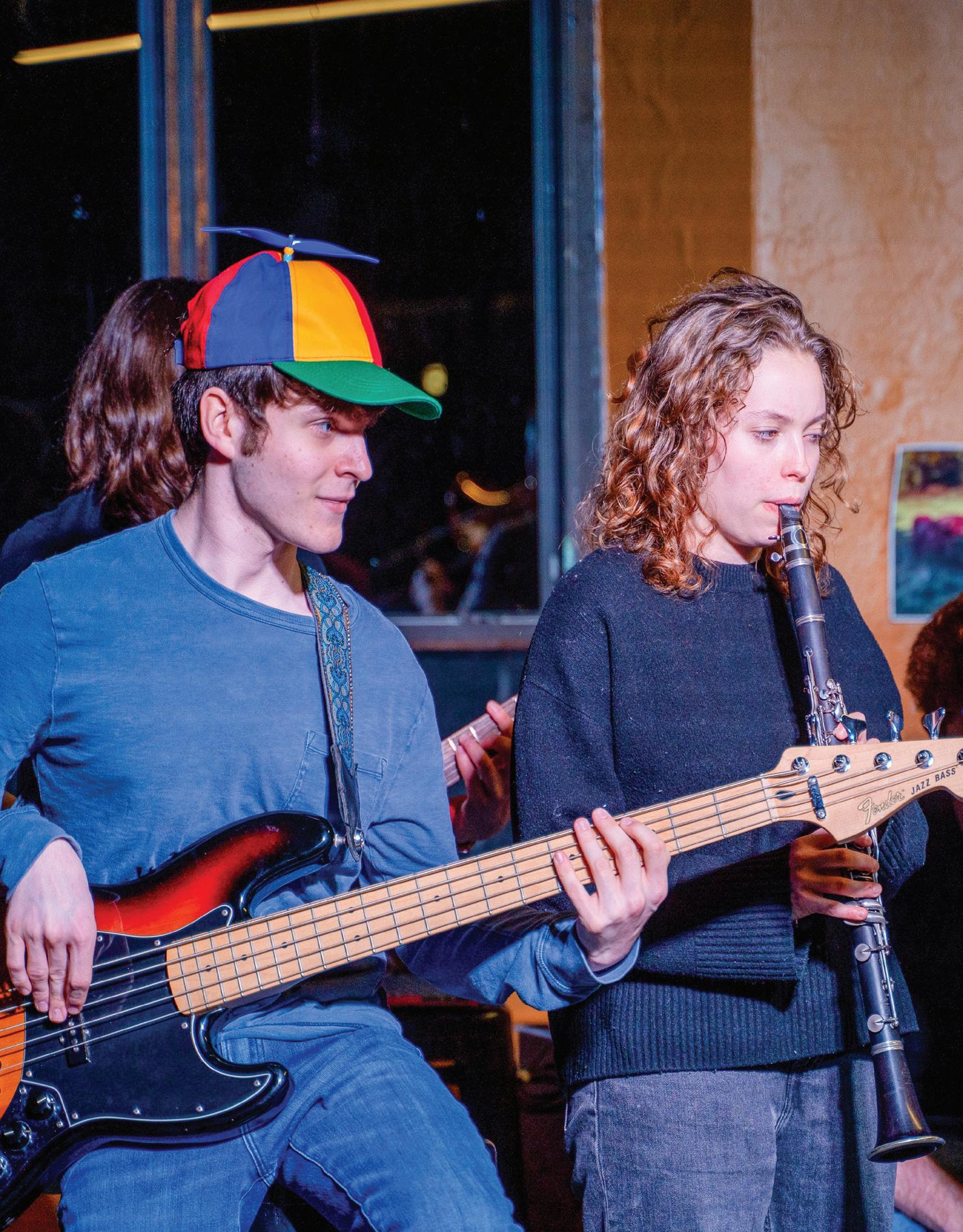

honest, fair.” He pointed out an interesting voting trend, “If you read the interviews with people who voted for Trump, they acknowledged all the things that had been reported. They acknowledged his issues with women. I mean, every voter we asked, they didn’t say we don’t believe that. They said ‘yes, we believe that, but we voted for him for this reason.”
The moderators proceeded to discuss how litigation affects the media, focusing on Trump’s legal battle against Columbia Broadcasting System. Baquet shared his concerns for smaller media outlets, raising the example of a local newsroom with which he often works in Mississippi, “I worry as much about those cases that get a lot less attention, because news organizations right now, unlike 30-40 years ago when we were all rolling in cash and felt really protected by the court systems, news organizations today are struggling financially
… I worry about that a lot.”
Baquet currently serves as Executive Editor of The New York Times’ Local Investigations Fellowship, which helps journalists from around the country in local newsrooms tackle high-impact investigative work in their communities. He pointed out the disadvantage that smaller newsrooms face adding “in a way, the fear of a lawsuit is as deadening as a lawsuit, right? I mean, when I was an investigative reporter, you sit down, you write a story, you really strive for fairness, you really strive for balance. ” He continued, “And these newsrooms that are smaller, that's hard to do anyway, because it takes a while … It's going to make you think a lot harder as you assign stories. It's going to make you say, Well, you know, if we investigate that guy, he might sue us. Let's talk about that. Once you say that, I'm worried, let's talk about it. That is not a journalistic
discussion.”
As the discussion focused on the polarization of the media, Baquet asserted that “the job of a news organization like The New York Times is not to be the enemy of Donald Trump.” He stressed the importance of conducting extensive research and gaining a strong knowledge of the facts before reporting on a topic.
Baquet drew a comparison between Artificial Intelligence and the creation of the internet and its integration into the newsroom. He cautioned that AI should be emrbaced as a tool for the betterment of journalism rather than a dangerous force to counter. “It’s gonna be as revolutionary as the internet. We should dive right in, learn everything we can about it, and seize it, and not pretend that it’s some evil thing lurking because the last time we did that, we got screwed.”
“reset governance and create [a] hybrid budget, model for the institution, hybrid governance for the institution, and above all, give agency to the faculty.”
Levine concluded his address by thanking the meeting attendees for considering the plan.
Lenowitz then explained the voting and discussion rules for the faculty members physically present and in virtual attendance on Zoom. He explained that they were not there to vote in favor or against the resolution during the meeting. The meeting’s final vote would only be to close debate about the motion’s content.
The motion reads as follows: “Resolved, that the faculty authorize the president and the provost to further develop a new structure for the University that combines the School of Arts & Sciences, Heller and Brandeis International Business School into four new administrative units. Each of these units will be led by an academic dean who reports to the provost, aided by vice provosts focusing on the innovation at the undergraduate and graduate level. This vote is made with the expectation that coordinating handbook changes will be presented for faculty vote at two meetings this spring.” In short, this vote would decide whether or not this reorganizational plan will continue to develop.
Lenowitz explained that the Faculty Senate was initially going to be neutral in this vote, as it was in the vote of no confidence against former University President Ronald Liebowitz; however, over the course of the last month, Senate members actively participated in campus discussions among themselves and with constituents, and changed their plan. Save for one abstention, Lenowitz said the faculty senate voted unanimously to support the resolution. He called on Faculty Senate council member Prof. Darlene Brooks Hedstrom (NEJS) to read the faculty senate’s statement of support.
“As representatives from across the faculty, we recognize that this proposal will affect departments, programs and schools in different ways and not be everyone’s ideal,” Hedstrom said. “However, we believe it is the best available path forward for Brandeis as a whole, aligning with our commitment to one Brandeis.” She explained that the Faculty Senate supports this resolution because of its potential to foster creativity and collaboration, as well as opportunities for innovation. Furthermore, Hedstrom said that the plan ensures that Brandeis is preserving its existing strengths. In addition, the reorganization plan “integrates parts of the arts and sciences with their applications, strengthening pedagogy and research while addressing needs expressed by students, parents and employers.”
Hedstrom said the plan allows the University to create financial models that are better suited to support long term stability and growth. Lastly, she said it is already supported by the Board of Trustees. After she concluded her statement, Lenowitz asked for an attendee to second the statement, as it is in favor of the motion. An attendee seconded the motion, and Lenowitz then asked if there was anyone willing to speak in opposition to it.
From Zoom, Prof. Benjamin Gomes-Casseres ’76 (BUS) said that he teaches classes on restructuring organizations in businesses to make them perform better. He said that while the idea of practical liberal arts is a fantastic goal, he was “sad to say that this plan would fail [his] midterm because it simply does not answer the question.” Gomes-Casseres explained that the question is how the University can raise revenue, but this plan would centralize control and destroy revenue, instead.
He broke down how the reorganization plan could hurt each academic department, notably saying that faculty members at the Heller School and the International Business School will be “beheaded, dismembered and demoted.” He called for support for the School of Arts & Humanities at Brandeis, saying that faculty at BIBS are willing to
work with the department to raise revenue. Gomes-Casseres said that this reorganization plan will die if the International Business School loses its integrity.
“Mr. President, I beg you to hit pause on this vote, let us hammer out a better plan. It’s still possible for all of us to earn an A on this course,” he said. He concluded by reminding faculty members that they vote on a secret ballot.
Next to speak in favor of the motion was Prof. Bulbul Chakraborty (PHYS). She explained that the reorganization plan is making her feel excited about the University again after a long time and hopes that it will help resolve obstacles within teaching, innovating and research.
“In this existing structure, there are multiple places where information leaks out and you need to plug those gaps,” Chakraborty said.
Prof. Stephen Cecchetti (ECON) on Zoom offered an amendment to the motion, requesting to take out the resolution’s second sentence, which states, “Each of these units will be led by an academic dean who reports to the provost, aided by vice provosts focusing on the innovation at the undergraduate and graduate level.” He felt that a statement about the organizational structure of administration is unnecessary, and that the organizational structure is about the University instead. His amendment was seconded.
Lenowitz opened the floor for faculty members to speak in opposition to Cecchetti’s amendment.
Prof. Jill Greenlee (POL/WGS) argued that removing the resolution’s second sentence would leave faculty with “absolutely nothing to work with.” She said conversations over the past several weeks that convinced her that a centralized structure will be more beneficial to community members, and that removing the sentence will “gut” the resolution to the extent that it would no longer be useful.
Prof. Avital Rodal (BIOL) on Zoom also opposed the amendment, expressing that she could not see how this level of reorganization could happen without leadership. She said that the interim academic deans mentioned in the resolution will come from the Brandeis community, individuals who will guide the plan. She thinks the plan requires leadership for each unit to speak to the undergraduate and graduate programs, and that the plan cannot be further developed without official leadership.
Prof. Donald Shepherd (HELLER) spoke in favor of removing the sentence because he is concerned about the role of these vice provosts controlling the four units. The units at Heller and the International Business School that have been working well and appealing to donors, and he doesn’t wish to undermine them.
An attendee then called the amendment to vote, closing the debate. The amendment failed with 52 votes in favor and 176 against it. The meeting proceeded with deliberations about the full motion again.
Prof. Sarah Lamb (ANTH/WGS) re-opened the discussion in support of the resolution, expressing that it would be a “win-win” for the University to allow Heller and the International Business School to become more integrated into the arts and sciences. She added that undergraduate and graduate students will also have more opportunities to help with marketing prospects. Not to mention, she believes this plan will help Brandeis solve budgetary challenges and “help enhance the Brandeis that we all love.”
Prof. David Powelstock (RUS) on Zoom expressed his enthusiasm about moving forward with a plan and that faculty are being invited as “partners.” He suggested removing “aided by vice provosts focusing on the innovation at the undergraduate and graduate level” from the second sentence rather than all of it as Cecchetti previously advised. “I don’t see those provosts as having clearly defined roles at this stage … I see them as extraneous leadership,” he clarified.
An attendee seconded this amendment, opening deliberations. Prof. Karen Donlean (HELLER) spoke in favor of Powelstock’s
amendment. She specifically pointed to a lack of clarity in their roles and expressed concern about the University being able to afford new faculty members.
Professor Gomes-Casseres spoke in favor of the amendment, questioning why there needs to be upper level supervision for faculty, reiterating his concerns about the integrity of the Heller School being destroyed. “The graduate classes are attracting students to graduate schools, they come because it’s a business school. Not because it is a unit,” he said, saying that integration does not need to be split by these provost positions. “It breaks down the whole reason why we work.”
A faculty member called the amendment to vote, the outcome was 191 in favor and 31 opposed, meaning that the phrase regarding the vice provosts would remain.
From Zoom, Prof. Sarah Mayorga (SOC) reiterated the importance of the Board of Education’s support, expanding on the idea that the board wishes to collaborate with faculty members and will approve a larger draw from the endowment. In addition, she said this plan is an opportunity to think creatively.
An attendee asked if a vote in support of the motion would mean that the four academic units would be committed to having two vice provosts. In response, Christensen reassured the faculty that most of the uncertainty seems to come from not knowing everything that will happen after the vote.
“We acknowledge that the form we get to may not match what we do to get there,” Christensen answered. He said that the plan is set up to accommodate changes from administration and the Board of Trustees while it is in motion. While the details can be altered later on, Christensen explained that consent from the faculty is needed in order to start.
Prof. Sabine von Mering (WGS/ENVS) said that she is leaning towards voting for the resolution, but requested more information regarding how the plan will help the University’s financial crisis as it does not seem to save money. She emphasized that the University needs more revenue, which requires it to be innovative in order to get prospective students excited about attending.
Introduced by Prof. Sandra Cha (BUS) on Zoom, the last amendment suggested was to add the word “interim” before “vice provost” in the second sentence. An attendee seconded her amendment and deliberations began.
Prof. Jim Haber (BIOL) on Zoom spoke against Cha’s proposed amendment, explaining that undergraduate and graduate students have different needs — that fact does not go away just because the University is reorganizing. He said that there will always need to be someone responsible for graduate education who is distinct from the individual responsible for undergraduate education.
A faculty member then called the amendment to question, and their motion was seconded. Ultimately, 137 attendees voted against the amendment whereas 63 voted in favor.
The meeting concluded with this amendment vote and a reminder that the faculty will be voting on whether to pass this plan on this motion during their next meeting.
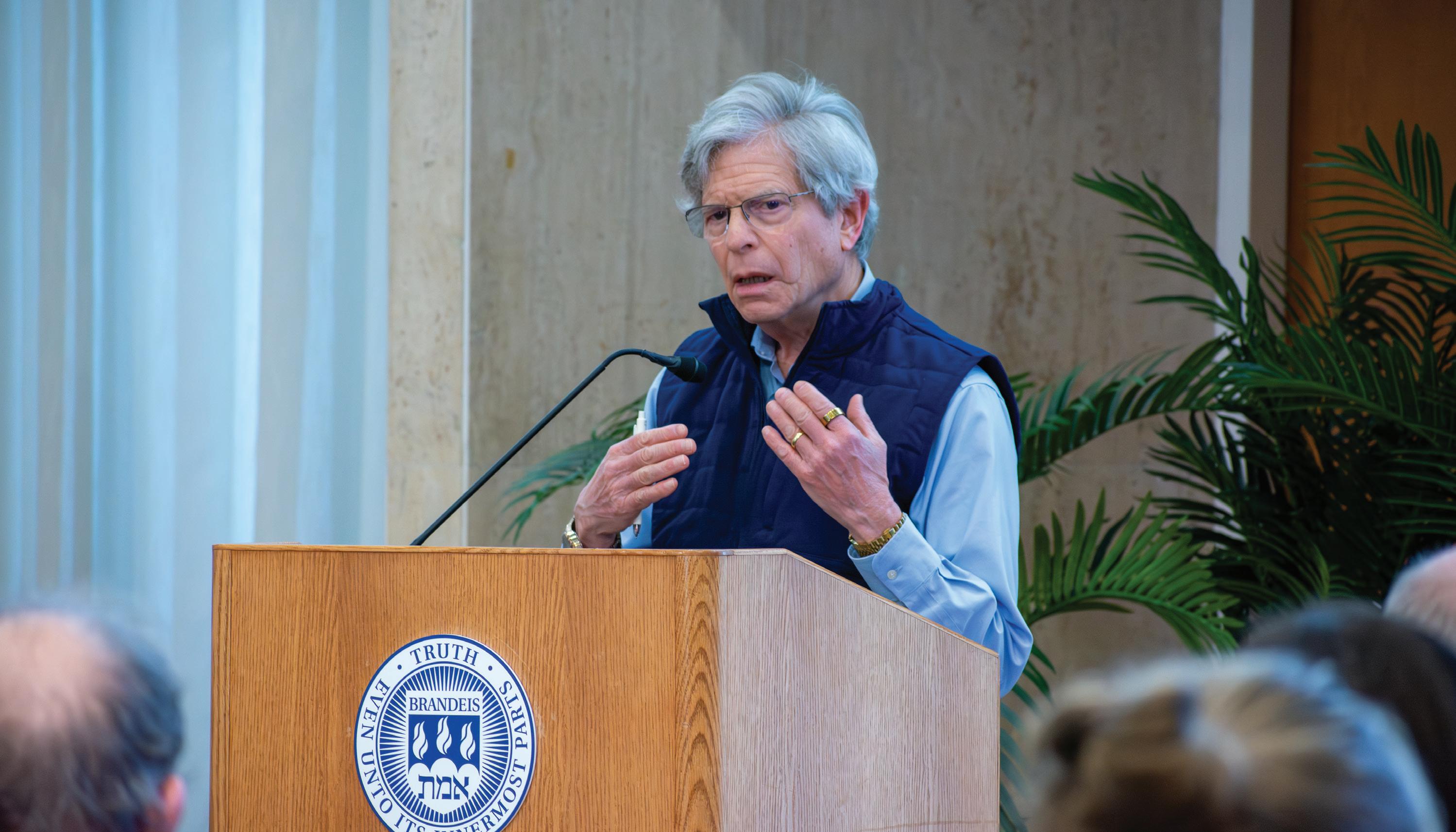
A man is not finished when he is defeated. He is finished when he quits.
ON THIS DAY…
In 1918, the Spanish influenza first arrived in the United States.
The sun is around 400 times larger than the moon.
With rapid changes in the political sphere following the election of President Donald Trump and developments in various Christian denominations, religious leaders are now facing more pressure than ever to address politics from the pulpit.
By GRACE DOH JUSTICE EDITOR
The week after the presidential win by former President Donald Trump, the heart of Boston saw a peculiar spectacle. Throngs of men in suits and religious garb populated the streets alongside an opposing parade of people, some dressed as clowns — wigs, red noses, the works. The pro-life “Men’s March,” organized by The National Men’s March to Abolish Abortion and Rally for Personhood, took place on Nov. 16, 2024 and culminated in over a hundred protestors marching from the Boston Planned Parenthood on Commonwealth Street to Boston Common.
The demonstration attracted a slew of counter protesters, some of whom were dressed as clowns to make a mockery of the anti-abortion rally. The counterprotesters wore costumes that mixed bright rainbow colors with bold geometric patterns that juxtaposed the Men’s March’s muted colors and solemn disposition. Some members of the Boston Clown March attendees came prepared with kazoos, harmonicas and recorders to drown out the noise of the anti-choice marchers. The Men’s March recited a Hail Mary while a marching band within the counter-protest group played a jaunty tune.
As these counter-protesters clashed with participants of the Men’s March and police enforcement, 17 people were arrested according to the official police report released the following Monday. While the march was not endorsed by the Boston Archdiocese, its context was undoubtedly a religious one. The evening before, Sacred Heart Church in Waltham hosted a prayer session and mass in honor of the Men’s March, as was advertised on Facebook by one of the organizers. In response, members of the First Parish, Waltham’s UnitarianUniversalist congregation, hosted a dueling prayer service which focused on reproductive justice. Reverend Elizabeth Carrier-Ladd led the service with the goal to “speak up for the rights of all people.” The organizers shared, “As UU’s we show up to side with love for all. We speak out when we see the forces of oppression that would take these rights away from any of us.”
Political strife has caused much division across Christian denominations. As some members begin to push for more wayward-thinking religious structures while facing resistance from conservative members, political strife has taken hold of once united denominations, causing split offs, schisms and disaffiliations across the globe.
The United Methodist Church has seen decades of debate and turmoil due to issues of sexuality in the church. In 2019, the UMC voted to tighten its ban
on same-sex marriage and the ordination of LGBTQ+ clergy members, a landmark moment in recent UMC developments. After this decision, thousands of churches began disaffiliating under a temporary measure that allowed churches to leave the UMC while keeping their properties and assets.
As of May 1, 2024, the UMC voted to allow LGBTQ+ clergy to serve after a 40 year ban. This historic outcome is a decisive mark of the times, as the vote on the consent calendar was 692-51 with a 93% approval rate.
The vote is a reflection of the thousands of Methodist ministries across the country who have been pushing for inclusivity of all identities, not just in their congregations but at all levels of involvement in the church. The BelmontWatertown United Methodist Church is one of many “reconciling churches” that boast these values. In light of the
and seeks to share fresh interpretations of the Bible for transformative faith.
Yi does not hesitate to directly address the current political climate from the pulpit as those issues relate to his clerical mission. Following the election, he preached on the relationship between Christianity and nationalism. “I clearly said at the beginning of my sermon that my anger and disappointments were not only because of the election results,” Yi told The Justice in a Dec. 18 interview. Rather, his concern as a citizen and as a spiritual leader was with the criteria that voters considered before casting their votes. “When the number one principle to choose a candidate is economics, that is really dangerous,” he explained. To Yi, the sole prioritization of the economy is what seems to disrupt the moral and ethical fabric of the nation.
Despite preaching openly about cur -
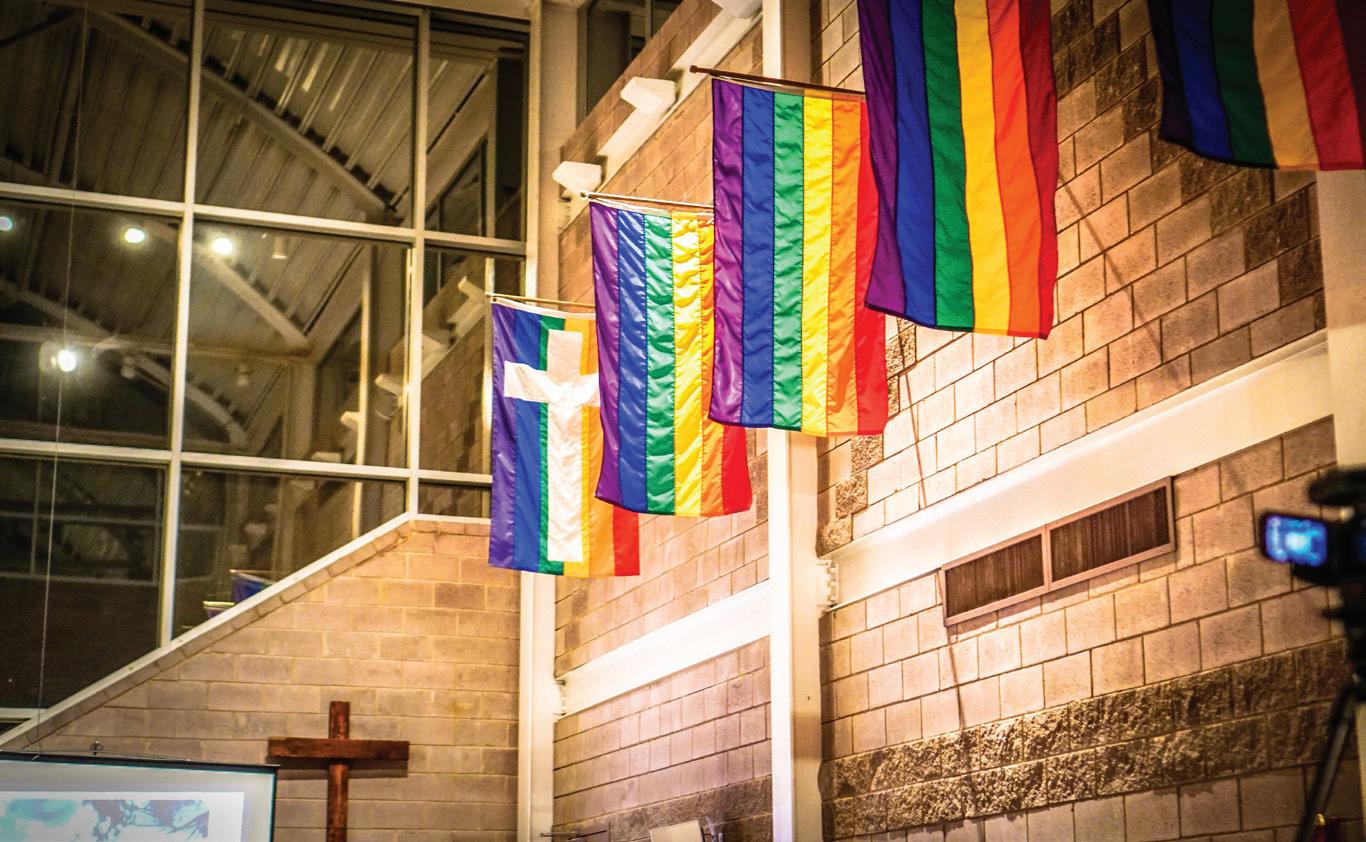
May 1 vote at the general UMC conference, the church website states, “we want to affirm that we are an inclusive congregation and all are welcome here.”
It sits below a statement that says that they celebrate all persons “and welcome them into the full participation in the life of this beloved community.”
In 2012, the Belmont United Methodist Church and St. John’s United Methodist Church in Watertown joined to form a new congregation. They now operate from both sites, holding worship services at the Belmont location and Alcoholics Anonymous and other programming at the Watertown location. Services are led by Reverend Aaron Yi, who was born into a Korean Methodist Christian family and went on to study theology and music in Munich, Paris and Boston. Yi holds an innovative and forwardthinking approach to leading worship
rent political issues, Yi emphasized that the church’s job is not to advocate for specific public policies or any one leader’s personal stance. His approach is to return to passages in the Bible and carefully apply those messages to contemporary contexts.
On the precarious future of the church, Yi said that one thing is clear: if the church does not embrace diversity, it will die. “We have to open the church doors towards new possibilities, a new generation, new people and new ideas,” he remarked.
While Methodist churches have been in a moment of political polarization and are only now beginning to diverge from its long-held stances on LGBTQ+ marriages and ordinations this election year, the Evangelical Lutheran Church in America is considered one of the most welcoming denominations to both
LGBTQ+ congregants and clergy and generally leans left on social issues. The ELCA, which is the largest Lutheran church body in the U.S., lifted their ban on gay clergy in 2009.
The First Lutheran Church of Waltham stands at the corner of Eddy and Weston Street, and a banner that reads “Reconciling in Christ. Welcome. Inclusion. Celebration” hangs from its front door. Their website reads a similar statement of inclusion to the Belmont-Watertown’s, welcoming people of all identities “to join us in worship, leadership, participation in rites and sacraments of the church, and fellowship.”
Reverend Thomas Maehl has been leading First Lutheran since 1999 after a decade-long career as a software developer. On Dec. 18, 2024, he spoke to The Justice about his thoughts on the church and how he has chosen to address the political landscape following the election.
Like Yi, Maehl chooses not to champion personal stances but rather to confront the various responses to contentious political disputes with one question: “how do you start with Jesus and end up here?” With this approach of curiosity, Maehl works to open up channels of conversations rather than to criticize an opposing viewpoint.
“I just think we’re not listening to each other,” he said. These open conversations within the congregation are the backbone of Maehl’s pastoral leadership. The welcoming statements on the church’s website, for instance, were voted on as a congregation.
Beyond the church community itself, First Lutheran is active in mutual aid initiatives in Waltham. They own nine affordable housing units, all run by a volunteer board. Another group of 15 people is working to resettle a family seeking asylum from Haiti. They have a Justice and Service Team that works on a number of different projects from food pantries to refugee support.
These stories of engagement from Boston’s streets to the pews of its churches speak to a long-cultivated tension at the heart of American religious communities. Whether through protests, prayer services or grassroots initiatives, congregations are grappling with how they should respond to an increasingly polarized political and religious landscape. Leaders like Yi and Maehl offer a path forward: one that prioritizes dialogue, compassion and service as bridges across the divide.
Something in the water: Why have so many major artists gotten their big break after performing at Brandeis?
Rapper Kendrick Lamar most recently performed at the Super Bowl Halftime Show but his humble beginnings date all the way back to the spring of 2013, right here on Chapel’s Field — and he’s not the only one
By BRIANNA EARLE JUSTICE EDITORIAL ASSISTANT
Springfest, the annual Brandeis concert that takes place just before finals period, has hosted a plethora of popular musicians throughout the years. Before this annual event, Brandeis hosted numerous artists as part of the Festival of the Creative Arts, student-led festivals and as a participating venue in various college concert series throughout the late 20th century.
Looking back on the concert lineups of Brandeis’ past, there is an incredible number of notable artists who have performed. From Bob Dylan to No Doubt, a wide variety of up-and-coming musicians rose to stardom following their performances here.
Many Brandeis students are familiar with Bob Dylan’s performance at the University in 1963, and others have become familiar with it since the debut of the live album “In Concert – Brandeis University 1963.” Released in 2011, the album was a joint effort between Columbia Records and Legacy Records. Recorded in May 1963, the live album includes Dylan’s entire performance from the very first annual Brandeis Folk Festival.

Brandeis alumnus Arnie Reisman ’64 told BrandeisNOW that the famous recording of Dylan’s performance was impromptu and uncomplicated. He said, “There was a tape being done by the University. From what I recall, there was only one tape recorder that was patched into the microphone.” The live album was recorded just two weeks prior to the release of Dylan’s sophomore album, “The Freewheelin’ Bob Dylan,” which skyrocketed him to fame. Dylan was not the only notable musician to play at the first annual Folk Festival. The concert lineup also included popular names in folk music such as Pete Seeger and Jean Ritchie. Dylan’s appearance at Brandeis in 1963 may have been his first time at the University, but it was not the last. More than a decade later, in November 1975, Dylan played a show at the Gosman Sports and Convocation Center as part of the Rolling Thunder Revue tour accompanied by Joan Baez and Joni Mitchell.
Brandeis alumna Betsy Pfau ’74 recalled her experience at the performance in a blog post. She writes, “It was a secret. We only knew about it because a good friend on the Brandeis Student Senate contacted us. We had already graduated, but he got us tickets and we lined up outside the gym on that cold November night in 1975, waiting for legends of our musical lives: Dylan and Baez (performing together for the first time in 10 years), Roger McGuinn, Ronee Blakley, hot off ‘Nashville’; we didn’t know it, but Joni Mitchell would make a guest appearance.” Just a few years later, the Ramones performed on that same stage. In 1982, the popular punk-rock band
drew a large crowd for their 30 song performance, but it garnered mixed reviews. “The furious pace and harddriving rhythms which makes the Ramones, were there. The vitality and spark which make a good rock concert were not. It could have been a movie of the Ramones for all of the audience/band interaction that took place,” wrote student Neil Safran in the April 29, 1982 edition of The Justice. Although they didn’t get their start at Brandeis, the Ramones continued to grow in popularity after their appearance here, culminating in their induction into the Rock and Roll Hall of Fame in 2002.
Just a decade down the road, 1996 was a big year for music at Brandeis. Riding the high of her hit album, “Jagged Little Pill,” Alanis Morissette made an appearance at Brandeis in early 1996. Despite being sick with a cold, she still managed to deliver an impressive show.

Later that year, Gwen Stefani and her band “No Doubt” appeared on the same stage in June as part of a summer concert series. Playing as an opener for 311, the band had gained recent success with the single “Just A Girl.” Following this performance, No Doubt went on to win two Grammys for the album, and also earned other nominations. Their success only grew from there as they headlined their own tour following the performance at Gosman.
Moving into the 21st century, Brandeis organizers continued to scout talent that would go on to soar in fame. In 2004, John Mayer attracted a flock of fans composed of Brandeis students and others in the greater Boston area. Student Andrew Katz ’05 recounted the

evening in an article for The Justice. He wrote, “Around 4,500 people packed into the athletic center which was masterfully transformed into a concert venue. Buses arrived from Bentley [University], cars arrived from the neighboring towns and colleges, and droves of people walked and took trains to join the community in seeing this huge act. There was even a smattering of townies, as many Waltham residents, some way beyond collegeage, intermixed with the young crowd.” Mayer, who is currently touring with “Dead and Company,” has had continued success post-Brandeis.
Although many of the past performances here have been folk and rock focused, Brandeis has recently broadened their horizons into pop and rap music. Artist Childish Gambino who rose to fame in both acting and performing, took the stage at Springfest 2012 and attracted a herd of spectators. “Childish Gambino was
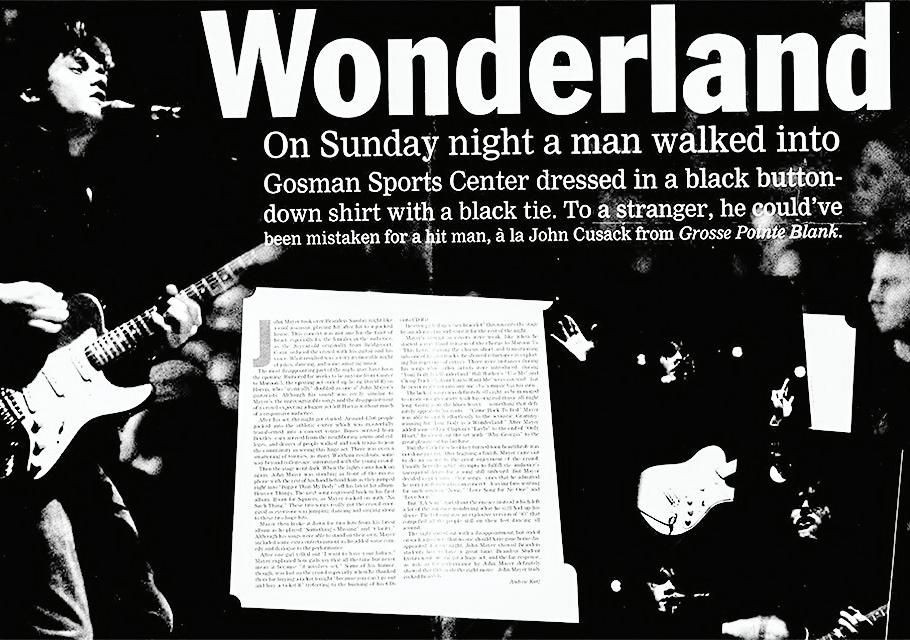
charming. Up close, his personality really came through in his speech and ability to entertain. The moments of melody in his songs were quite nice, showing off his strong vocals. His rapping was okay, but his overall performance was definitely enhanced by his commitment to strong showmanship. With a mixture of live and recorded backup music as well as a digital display with interesting graphics and lyrics, Childish Gambino’s set was a great way to end the afternoon,” said Emily Salloway ’13 in a 2012 Justice article.
The year following was just as exciting, with Kendrick Lamar headlining. In April of 2013, Lamar took the stage on Chapels Field. Just beginning his crawl up the rap royalty ladder, he captivated the audience with his Springfest set. Zach Goulet ’16 said in a 2013 Justice article, “it was extremely evident that Lamar was indeed the headliner and artist about whom every single member of the massive audience that almost completely packed the field was most thrilled. The rapper commanded the crowd with the prowess of a weathered star.”
It was only up from there for Lamar. His fourth album, “DAMN” skyrocketed him into extraordinary success and landed him an incredible honor; he became the first rapper to win the Pulitzer Prize in music in 2018 and continued to climb the charts after his performance
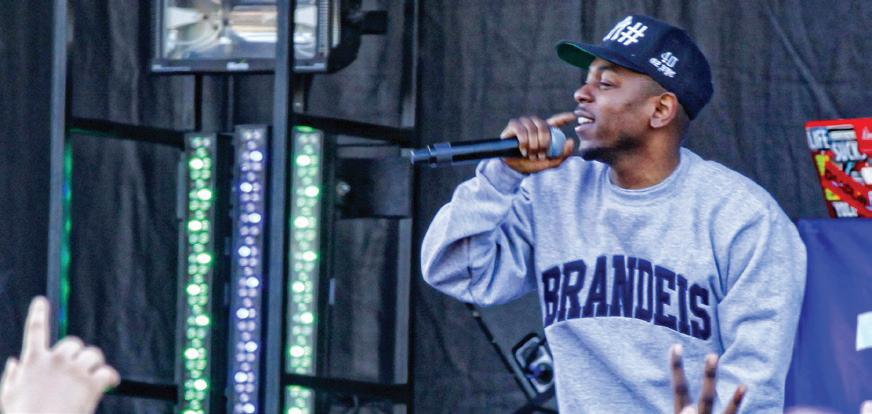
at Brandeis. This past February, he performed as the headliner for the Super Bowl Halftime Show, which writers at the New York Times dubbed as political art. Brandeis students were able to experience the rap icon’s undeniable talent first-hand, just before he rose to unreachable heights.
Upperclassmen may remember when Doechii performed at Springfest 2023. Despite the gloomy, pouring rain landscape that accompanied her, the turnout was large and Brandeis students were still eager to be involved in the fun. Although she was fairly unknown at the time — slowly growing a fan base online on platforms like TikTok — Doechii is now set to receive Billboard’s Woman of the Year award. Woman of the year is not the first award she’s received this year. She was also the winner of the Grammy for Best Rap Album of the year. These victories are evidence of Doechii’s growing success, and students at Brandeis were some of the first people to witness it firsthand.
With a pattern like this, it is hard not to wonder: who will be the next mega-star to make the transition from Chapels Field to Madison Square Garden?
Established 1949
Anna Martin, Editor in Chief
Eliza Bier, Managing Editor
Isabel Roseth, Senior Editor
Leah Breakstone, Tibria Brown, Sophia De Lisi, Julia Hardy, Lauryn Williams, Deputy Editors
Xilei Ceci Chen, Dalya Koller, Mina Rowland, Associate Editors
Lil Lin Hutchinson, Zoe Zachary, News Editors
Grace Doh, Features Editor
Ariana Rich, Forum Editor
Nemma Kalra, Arts & Culture Editor
Jonas Kaplin, Bryan Wolfe, Photography Editors
Lily Chafe, Sara Samuel, Copy Editors
Marina Rosenthal, Layout Editor
Elizabeth Liu, Advertising Editor
Amanda Chen, Niámh Mullen, Social Media Editors
Regardless of which bubble you filled in last November — or whether you filled one in at all — the role of the press in shaping public discourse and accountability remains important. Journalism has undergone a profound transformation, evolving into an industry that surpasses even the most ambitious visions of our nation’s founders. Yet, recent developments have cast a troubling shadow over the future of a free and independent press, raising urgent concerns about its integrity and sustainability.
As an editorial board composed of many aspiring journalists, we observe these shifts from our Brandeis bubble with a growing sense of trepidation. The First Amendment enshrines press freedom as a fundamental right, and we have long believed that, despite the industry’s challenges, there would always be a space for us within it. However, we have watched our peers struggle as entry-level government positions, once within reach, have disappeared amid sweeping budget cuts and diminishing federal support. Journalism is not merely an institution — it is the foundation upon which an informed society is built.
Prior to the most recent presidential election, we witnessed an alarming instance of editorial interference when Jeff Bezos, the billionaire owner of Amazon and The Washington Post, refused to publish the editorial board’s already completed endorsement of candidate Kamala Harris. To some, this may have seemed inconsequential, but to this editorial board, it signaled a profound betrayal. A publication bearing the slogan “Democracy Dies in Darkness” was once a beacon of journalistic integrity; now, it stands compromised.
Bezos’ intervention did not end there. This past week, the self proclaimed “hands-off” owner of The Post made yet another grave misstep, dispatching a directive to staff regarding the future of the paper’s opinion section. In his statement, Bezos declared that The Post would henceforth devote itself to “writing every day in support and defense of two pillars: personal liberties and free markets.” This decision prompted the resignation of David Shipley, the former opinions editor, who had opposed such ideological constraints for months. As The New York Times reported, Shipley argued that Bezos’ mandate would erode the diversity of viewpoints that had long defined the paper’s editorial pages.
The consequences of this shift have been swift and severe. Since the announcement, The Washington Post has hemorrhaged over 75,000 subscribers — members of this board among them. This loss compounds the fallout from Bezos’ initial refusal to publish the endorsement editorial, bringing the paper’s total subscriber deficit to more than 300,000 in just a matter of a few months. A once-revered institution now stands as a cautionary tale of what happens when journalism is
allegiance.
Journalism is, by nature, an evolving industry — one that thrives on a continuous influx of fresh talent and the wisdom of seasoned mentors. However, we now face a pivotal moment in which the industry’s very future is at stake. The influence of political and corporate forces has always been present in the media, but we have reached a critical juncture where these forces threaten to undermine the press’ core purpose. Moving forward, the only viable path is one
subordinated to corporate interests.
News organizations have historically had political affiliations; in fact, many were originally funded by political parties. The editorial pages have always served a singular purpose: to present informed opinions, offer guidance and articulate visions for the future.
As esteemed journalists depart The Post in pursuit of opportunities at publications that uphold the core tenets of the press, we support their decision to prioritize journalistic integrity over financial and political pressures. We lament the loss of what was once a dream job for so many of us, and we mourn the erosion of trust in an institution that should champion truth, not agendadriven narratives.
This editorial board also stands in solidarity with the journalists of the Associated Press, a globally recognized source of independent reporting. The AP’s commitment to factual, unbiased journalism was met with retaliation when President Donald Trump expelled its reporters from the White House Press Pool after the organization refused to adopt his administration’s directive to rename the Gulf of Mexico as the “Gulf of America.” The AP plays a crucial role in supporting local newsrooms that lack the resources to report on national and international affairs. Without such institutions, the fabric of informed democracy begins to fray.
In response to this expulsion, White House Press Secretary Karoline Leavitt defended the administration’s decision, stating that inclusion in the press pool is “a privilege, not a right.” This statement forces us to confront an unsettling question: if access to unbiased information is deemed a privilege, does this administration also consider being an informed voter a privilege rather than a right?
Compounding this concern is the administration’s recent decision to handpick which news organizations may cover the president, effectively curating the questions posed to him and shaping his public portrayal. According to The New York Times, this move breaks decades of precedent, wherein the White House press corps functioned as an independent entity. Eugene Daniels, President of the White House Correspondents’ Association, denounced the decision, stating “this move tears at the independence of a free press in the United States … It suggests the government will choose the journalists who cover the president. In a free country, leaders must not be able to choose their own press corps.”
As both aspiring journalists and news consumers, we find this development profoundly alarming. The United States was founded on principles of freedom and education — both in terms of free speech and a free press. We firmly believe that every individual in this nation has the right to be informed regarding the workings of their government, a right that transcends partisan
of unity among news organizations. We call on publications to set aside their differences and present a united front in defense of freedom of the press. As young journalists on the cusp of entering this profession, we urge those who came before us to safeguard the integrity of the industry that we have dedicated ourselves to joining. While we are grateful for the platform we have as The Justice editorial board, we remain apprehensive about the future. Yet, in our pursuit of truth, we remain resolute; journalism must endure, and democracy must
to learn.
Joel Christensen
Every week with increasing volume tells us this: higher education is in trouble. It is too expensive. There aren’t enough students to go around. Schools are going to close. And those that remain will be different from what they were before. People aren’t sure they should spend four years of their life learning things they can’t apply to jobs that might not be there when they’re done.
Higher ed is beset by political turmoil, disrupted by technological change, threatened by rising income inequality, peering over the edge of a ‘demographic cliff’, and looking ahead at the uncertainty of climate change. To survive we need to change. And the changes we need to make are hard. But at Brandeis we have a chance to make sure they don’t change what makes us special. What makes us different is exactly what makes us the best place to lead this change
Stories
Let me tell you a story.
I grew up on a dirt road in southern Maine. I only applied to schools in the Boston area and included Brandeis because the only teacher at my high school with a PhD went there. I never saw Brandeis before I moved in. I didn’t know a thing about its faculty or reputation apart from its ranking and a tradition of being pretty liberal, and a little bit weird. (I had read Abbie Hoffman’s Steal This Book before high school and imagined a campus populated by protestors and poets.)
I knew I loved literature and the classics before I arrived on campus and from the first day until the last my teachers brought me into their world. Whether it was in a poetry seminar, a funded mentoring program for students interested in a career in education, or my independent research for my senior thesis, I found faculty who were serious about their work, but wanted to bring students into it too. The training I received in and out of the classroom and the mentoring that continued after I graduated changed the way I saw the worlds What I didn’t realize at the time was that Brandeis was—and is— special: it offered me the small classrooms and faculty access typical of a liberal arts school along with the world-class research opportunities of an R1 institution. That combination of access and expertise changed my life.
Let me tell you another story.
I met my wife, Shahnaaz, in our third week at Brandeis. She grew up in Connecticut after her family immigrated from India when she was 4. In her first semester at Brandeis, she was enrolled in four languages and had vague ideas of wanting to go into advertising or business. She thought about transferring that first year because she couldn’t make sense of what she’d do afterwards.
But then she rediscovered art. She took printmaking and painting and turned her love for languages into a linguistics major. But our experience went beyond the classroom. Shahnaaz got experience working on campus, learning graphic design and marketing in the communications office, and her way around the office as a work study student in Rosenstiel basic sciences. We started a literary art magazine our junior year.
At first, Brandeis didn’t give Shahnaaz a career. We moved to New York in the summer of 2001 and she tried real estate and teaching, even getting accepted into Teach for America before she decided, much to both of our surprise, that she wanted to be a dentist. She went back to school and proceeded to ace every science and math requirement she had avoided as an undergraduate: the variety of courses she took at Brandeis had taught her how
Shahnaaz got into every dental school she applied to, thanks to her grades, majors that set her apart from other applications, and the quality of her undergraduate diploma. Her ability to speak across disciplines and perspectives was crucial to her success: She went to Columbia, joined the Army to pay for it, and is now a pediatric dentist with practices in Haverhill and Peabody.
Shahnaaz and I benefited from the best that Brandeis had to offer: the invigorating, yet supportive intimacy of a small liberal arts college with access to world-class expertise. We learned how to learn in our classrooms, but also developed skills in our campus jobs, and crucial experience of our own in research projects like our senior theses. We built relationships with mentors who guided us years after we graduated and friendships we maintain to this very day. And we pursued careers that were more than jobs, grounded in a commitment to others and public service. The Need to Re-imagine
This unique combination of size and knowledge, empowered by a historical mission of accessibility, a commitment to excellence, and a dedication to healing the world makes Brandeis special, not the academic reporting structure or our budget model. The problem is that what makes us special isn’t visible enough, that the students and parents of today can’t see clearly all that we have to offer. And we haven’t been able to offer it to every student.
The liberal arts provides students with the knowledge and skills to adapt in an unpredictable world. But given its high cost and the unpredictable economy of a digital and globalized world, too many have lost faith in this promise. So, we need to show them the way. We need to adapt and offer a clearer view of how our degrees provide students with the skills they need for today and tomorrow. We need to restructure to make sure that every student who comes here has the chance to learn our academic disciplines and their applications. We need to anticipate what they will need to face a changing world and lead higher education in updating the liberal arts for the 21st century. We have the expertise and the human resources to do this: across campus we have internationally known scholars in every discipline; we have phenomenal teachers; we have cutting edge research that produces scholars like those who laid the foundation for the COVID19 vaccine. Our graduates are business executives, artists, lawyers, doctors, activists, teachers, and more. They are out there healing the world on a daily basis because they started here.
President Levine’s proposed reorganization makes what we do more visible, but it also puts our academic and professional programs in conversation and invites all of us to look out into the world to see how we can shape it. Each of the new units will be positioned to offer new programs and degrees that will attract new students and we will offer new credentials that makes their skills and experiences legible to the world. We will streamline academic leadership with a focus on designing and supporting new programs. We will provide the new institution with the structure to reward increased enrollment and innovation, to reinvest in thriving programs and to take the time to reinvent those that continue to inspire us.
Our vision of the future is one where Brandeis leads by example, where we have redefined what a school our size can do, and where we continue to live by the mission of our founding: to bring education and learning to those who have been excluded, to seek the truth in all of its form, and to produce research and people dedicated to making the world better for everyone.
By ESTHER BALABAN JUSTICE EDITORIAL ASSISTANT
■ Shifting free speech regulations within Brandeis organizations stifle political activity on campus, something highly detrimental in the current political climate.
On Feb. 9, Rabbi Seth Winberg, the Executive Director of Brandeis Hillel, sent an email to the Hillel mailing list titled “Addressing Misinformation about Hillel at Brandeis,” in which he referenced “false rumors that Hillel at Brandeis is supporting or assisting a group of students identifying as the ‘Jewish Bund.’” He clarified that Hillel does not recognize or support the Jewish Bund, a Jewish antiZionist socialist group on campus that was inspired by the Bundist movement. The Bund has recently released a list of demands on their Instagram page. Winberg claimed that the group has “conducted activities in the library that many students have found disruptive,” “misrepresented Hillel and [their] professional staff” and “tried to misuse Hillel’s space reservations for their activities.” He asserted that Hillel will be taking steps in response through established Brandeis channels and that this response is not about any particular group but rather a “matter of principle.” The vague description of how the Jewish Bund misrepresented Hillel and misused their spaces demanded further elaboration; however, the Jewish Bund has yet to release a statement on their Instagram page. I have reached out to both Hillel and the Jewish Bund for statements in hopes of clearing up the details of this issue, specifically asking about the “misuse of Hillel’s space reservation and misrepresentation of Hillel and the professional staff,” in order to provide both sides of the story.
Winberg responded on behalf of Hillel at Brandeis and reasserted that “Hillel at Brandeis is a welcoming community where students of all backgrounds can come together to celebrate and participate in Jewish life. We welcome all students — regardless of their Jewish practice, prior knowledge, political beliefs, financial means or any other aspect of their individual identity — to participate in our community. To foster this welcoming environment, all students are expected to uphold the standards of conduct set by both Hillel and the University.”
Winberg did not elaborate further on the issue; however, the point of “upholding the standards of conduct set by both Hillel and the University” has been an ongoing debate among Brandeis students and administration, especially as it pertains to the issue of free speech on campus. Actions have been taken in order to properly define and redefine Brandeis’ standards of conduct, such as the establishment of a Presidential Task Force on Free Expression on March 28, 2024, and issuing a message regarding “Social Justice and Free Expression” from Vice President of Student Affairs, Andrea Dine, and Vice President for Diversity, Equity and Inclusion, LeManuel Bitsóí, on Nov. 8, 2024. While I was unable to locate any explicit standard of
conduct from Hillel on either their website or in their emails, one can assume they adopt the same standards as the University. The constant evolution of what sort of free speech is allowed on campus makes it difficult for any sort of political organizing, something that is especially pertinent in today’s political climate.
The Jewish Bund was also asked about “misuse of Hillel’s space reservation and misrepresentation of Hillel and the professional staff,” and they outlined the issue in direct response to Winberg’s initial email. The full statement is included at the bottom of the publication. They assert that “Hillel does not assist the Bund in any organizational capacity. Moreover, the Bund has never tried to claim that it has Hillel’s backing,” supporting Hillel’s claim. The Bund provided their version of the full timeline of events that led to the accusations of misuse of Hillel space reservations for Bund activities.
“In reality, the Bund had received prior verbal authorization from an employee at Hillel to use their [Multi-Purpose Room] reservation in advance of the event. However, this authorization should not have been given, as was made clear two hours and 45 minutes before the event started when Rabbi Winberg emailed an organizer reversing the previous decision to allow the Bund to use the space. This [change] went unnoticed until organizers arrived at the MPR, at which point [Shapiro Campus Center] staff informed us that we had to vacate. We complied, and held Shabbat in a public area in cooperation with staff. To be clear, we did not use the MPR once the event had started, and vacated once we were informed by SCC staff. No Bund organizer spread any ‘rumors’ claiming that Hillel was facilitating our Shabbat (or any other events) beyond relaying the narrative above. In the end, that Shabbat dinner ended up being one of our most successful events so far, with great food, and uplifting singing and speeches!”
The Bund attained authorization from a Hillel employee, which was later rescinded. Upon being made aware of the change, they complied with the SCC staff, left the reserved space and held the Shabbat dinner in a public area.
In response to Hillel’s claim that the Jewish Bund “conducted activities in the library that many students have found disruptive, hindering its function as a space for focused study and scholarship,” the Bund stated: “While we respect that this claim comes from the desire to protect students from harassment, this statement is categorically false, and may embolden students to actually carry out said harassment.” They clarified that “All events held in the library have been done in coordination with library staff. The only students under threat of discrimination are those participating in the study-ins, or engaging in the productive discourse that they foster.”
Regarding the claim of the study-in being disruptive to study and scholarship, a police officer “directly asked uninvolved
students if the event was disruptive. The answer was unsurprisingly, ‘no,’ and, quoting The Justice, the police ‘determined no wrongdoing.’” The Jewish Bund asserts that “far-right Zionist students consistently attempt to dox and harass organizers and participants … These incidents (including doxxing attempts and illicit photographing) have been compiled and we are in contact with the university regarding next steps. Rabbi Winberg concludes the statement by implicitly encouraging students to report event organizers.” The Jewish students of the Bund have been the ones to bear the most harassment and antisemitism, with many anonymous users on the Brandeis Sidechat accusing them of being “self-hating Jews.”
Winberg’s email concluded with the statement: “We also envision a campus where free expression is upheld while all students — including Jewish students — are protected from harassment. I strongly encourage students with concerns about community standards, harassment, or discrimination to report them to the University.” This could easily be read as if the Jewish students involved in the Bund are seeing their free expression threatened by the risk of harassment from Zionist students that may be encouraged by Hillel to report the Bund. The Bund’s events have not raised any concerns about community standards or involved any sort of harassment or discrimination of other students. Additionally, The Justice reported that the study-in was “deemed peaceful and non-antisemitic” by the officer on the scene. The inclusion of this strong encouragement to close off the statement can be read as indirectly targeting the Bund and accusing them of harassment and discrimination against Jewish students — despite them being a Jewish organization and, as the Bund claims, “despite the fact that no university rules were violated on either occasion.”
Both statements have the aim of dispelling misinformation with the Bund stating “We understand that it is natural that rumors, especially when spread by the same students harassing others at events, have the capacity to do serious harm and generate confusion among Hillel and University staff and other students. As a result, we are not accusing anyone involved in creating the Hillel statement of deliberately misinforming,” claiming they gave their statement “feel[ing] it pertinent to give our perspective.” They conclude by asserting that “This will not deter us from organizing this semester. We understand our rights and responsibilities as a non-chartered student group at Brandeis, and will continue to work with staff in the public locations where we organize. We look forward to more successful events, including holding a Bund Shabbat again in the future!”
Bund statement in full:
Addressing Misinformation about the Jewish Bund at Brandeis In response to a statement by Rabbi Seth Winberg of Hillel regarding our Shabbat held on 1/31
On February 9th, it came to our attention that Rabbi Seth Winberg of Hillel published a statement regarding our most recent Shabbat dinner and university ‘study-ins’ which mischaracterized some of our activities. Before covering these mischaracterizations, it is important to acknowledge that, as Rabbi Winberg wrote, Hillel does not assist the Bund in any organizational capacity. Moreover, the Bund has never tried to claim that it has Hillel’s backing. The remainder of this address will be dedicated to clearing up inaccuracies present in Hillel’s email, the first of which being the claim that the Bund “tried to misuse Hillel’s space reservations for their activities.”
In reality, the Bund had received prior verbal authorization from an employee at Hillel to use their MPR reservation in advance of the event. This authorization should not have been given, as was made clear 2 hours and 45 minutes before the event started when Rabbi Winberg emailed an organizer reversing the previous decision to allow the Bund to use the space. This went unnoticed until organizers arrived at the MPR, at which point SCC staff informed us that we had to vacate. We complied, and held Shabbat in a public area in cooperation with staff. To be clear, we did not use the MPR once the event had started, and vacated once we were informed by SCC staff. No Bund organizer spread any ‘rumors’ claiming that Hillel was facilitating our Shabbat (or any other events) beyond relaying the narrative
above. In the end, that Shabbat dinner ended up being one of our most successful events so far, with great food, and uplifting singing and speeches!
Regarding our study-ins, Rabbi Winberg referred to these events as “activities in the library that many students have found disruptive, hindering its function as a space for focused study and scholarship.”
While we respect that this claim comes from the desire to protect students from harassment, this statement is categorically false, and may embolden students to actually carry out said harassment. All events held in the library have been done in coordination with library staff. The only students under threat of discrimination are those participating in the study-ins, or engaging in the productive discourse that they foster. As was reported in the Justice, far-right Zionist students consistently attempt to dox and harass organizers and participants. One agitator even called the police during our first study-in, after which an officer directly asked uninvolved students if the event was disruptive. The answer was unsurprisingly ‘no,’ and, quoting the Justice, the police “determined no wrongdoing.” These incidents (including doxxing attempts and illicit photographing) have been compiled and we are in contact with the university regarding next steps.
Rabbi Winberg concludes the statement by implicitly encouraging students to report event organizers. This is despite the fact that no university rules were violated on either occasion. We understand that it is natural that rumors, especially when spread by the same students harassing others at events, have the capacity to do serious harm and generate confusion among Hillel and University staff and other students. As a result, we are not accusing anyone involved in creating the Hillel statement of deliberately misinforming. Rabbi Winberg’s statement is titularly devoted to dispelling misinformation, and we feel it pertinent to give our perspective. This will not deter us from organizing this semester. We understand our rights and responsibilities as a non-chartered student group at Brandeis, and will continue to work with staff in the public locations where we organize. We look forward to more successful events, including holding a Bund Shabbat again in the future!
Winberg’s first email in full:
Late last week, I learned of false rumors that Hillel at Brandeis is supporting or assisting a group of students identifying as the “Jewish Bund.” I encourage everyone to approach rumors with skepticism and verify information before accepting it as fact. The group is not affiliated with Hillel, nor does it receive recognition or support from us. It is also not a recognized Brandeis student organization.
The Jewish Bund is an anti-Zionist group on campus that has, among other things, conducted activities in the library that many students have found disruptive, hindering its function as a space for focused study and scholarship.
Regrettably, some individuals connected with the Jewish Bund have misrepresented Hillel and our professional staff, and have tried to misuse Hillel’s space reservations for their activities. This is unacceptable, and we are exploring appropriate steps in response, including working through established Brandeis University channels. This is not about any particular group—it is a matter of principle and ensuring that all students adhere to the University’s Student Rights and Community Standards.
As a campus rabbi and Hillel professional, I recognize that misunderstandings about our role are inevitable. Some people may not fully appreciate Hillel’s deep commitment to nuance and education, as well as our unwavering support for Israel as a Jewish and democratic state with safe and secure borders. Others may hear only part of a conversation and take it out of context. These dynamics are natural in a diverse and intellectually engaged environment of young adults.
Hillel remains committed to fostering a welcoming, vibrant, and supportive Jewish community. We also envision a campus where free expression is upheld while all students— including Jewish students—are protected from harassment. I strongly encourage students with concerns about community standards, harassment, or discrimination to report them to the University.





■ As artificial intelligence becomes more common in everyday life, it has begun to infiltrate the athletic world.
By ANNA MARTIN JUSTICE EDITOR IN CHIEF
As technology advances, so does the landscape of professional and amateur athletics. Once viewed with skepticism and even fear, artificial intelligence has steadily integrated into daily life, shifting from a perceived threat to an indispensable tool of convenience and efficiency. Now, AI is making its mark in the world of sports, particularly in officiating. This innovation is fundamentally transforming the way games are played, reviewed, and experienced by both athletes and spectators.
The emergence of AI-driven officiating systems has not only streamlined the decision-making process but also significantly enhanced the accuracy and fairness of calls. This technological shift has reshaped the dynamics of sports, altering both the player’s experience and the audience's engagement with the game. According to Refr Sports, "AI in sports refereeing involves using advanced technology, like machine learning and computer vision, to assist in making more accurate and quick decisions during games. This technology is increasingly being used to complement the skills of human referees, ensuring fairness and enhancing the quality of play."

AI has already been incorporated into a wide range of sports, including football, tennis and baseball, revolutionizing how officiating decisions are made. However, AI in sports officiating is not a singular technology but rather an umbrella term encompassing multiple systems, each serving distinct purposes. Technologies such as Hawk-Eye, the Video Assistant Referee and ball-tracking systems have been deployed to ensure precision in calls, offering real-time insights that significantly reduce human error. These systems rely on vast datasets, including historical game footage, to recognize patterns, interpret rules and provide instant feedback

to referees. The adoption of AI in officiating has also mitigated the controversies surrounding subjective calls, offering greater transparency in highstakes moments.
Beyond decision-making, AI is playing an increasingly crucial role in athlete performance and health monitoring. AI-powered systems are capable of conducting player health assessments, identifying potential injury risks before they escalate into serious conditions. These tools analyze movement patterns, biomechanics, and historical data to predict injury susceptibility, allowing coaches and medical teams to implement preventative measures. A study published in the National Library of Medicine found that AI-driven injury prediction models could outperform traditional assessment methods by detecting subtle movement inefficiencies and generating predictive insights.
Furthermore, AI is revolutionizing game analysis, providing referees and analysts with deeper insights into gameplay. Machine learning algorithms process vast amounts of data to generate tactical evaluations, helping referees better understand game dynamics and refine their decision-making processes. According to a report by SportsTechX, AI-based analytics have led to increased efficiency in officiating and coaching strategies, as well as improved fairness in competitive sports.
Despite its many benefits, the integration of AI in sports officiating is not without challenges. Some critics argue that an overreliance on technology may diminish the human element of the game, reducing the influence of experienced referees who bring contextual judgment and intuition to their calls. Additionally, concerns regarding the ethical implications of AI decision-making, data privacy, and potential biases in algorithmic programming continue to be subjects of debate. However, proponents of AI-driven officiating maintain that these technologies serve as tools to aid, rather than replace, human referees, ensuring a more just and transparent sporting environment.
As AI continues to evolve, its role in sports will only expand, further refining the accuracy, efficiency and fairness of officiating. With advancements in machine learning and real-time data processing, the future of AI in sports promises even greater levels of precision, ultimately redefining the standards of athletic competition. The question remains not whether AI will continue to shape the future of sports, but rather how leagues, referees and governing bodies will adapt to its growing influence.
Brandeis Softball opens their season on the East Coast this Saturday against Wentworth Institute of Technology after a tough start in their spring training trip in California. Go cheer on your Judges at Marcus Field!
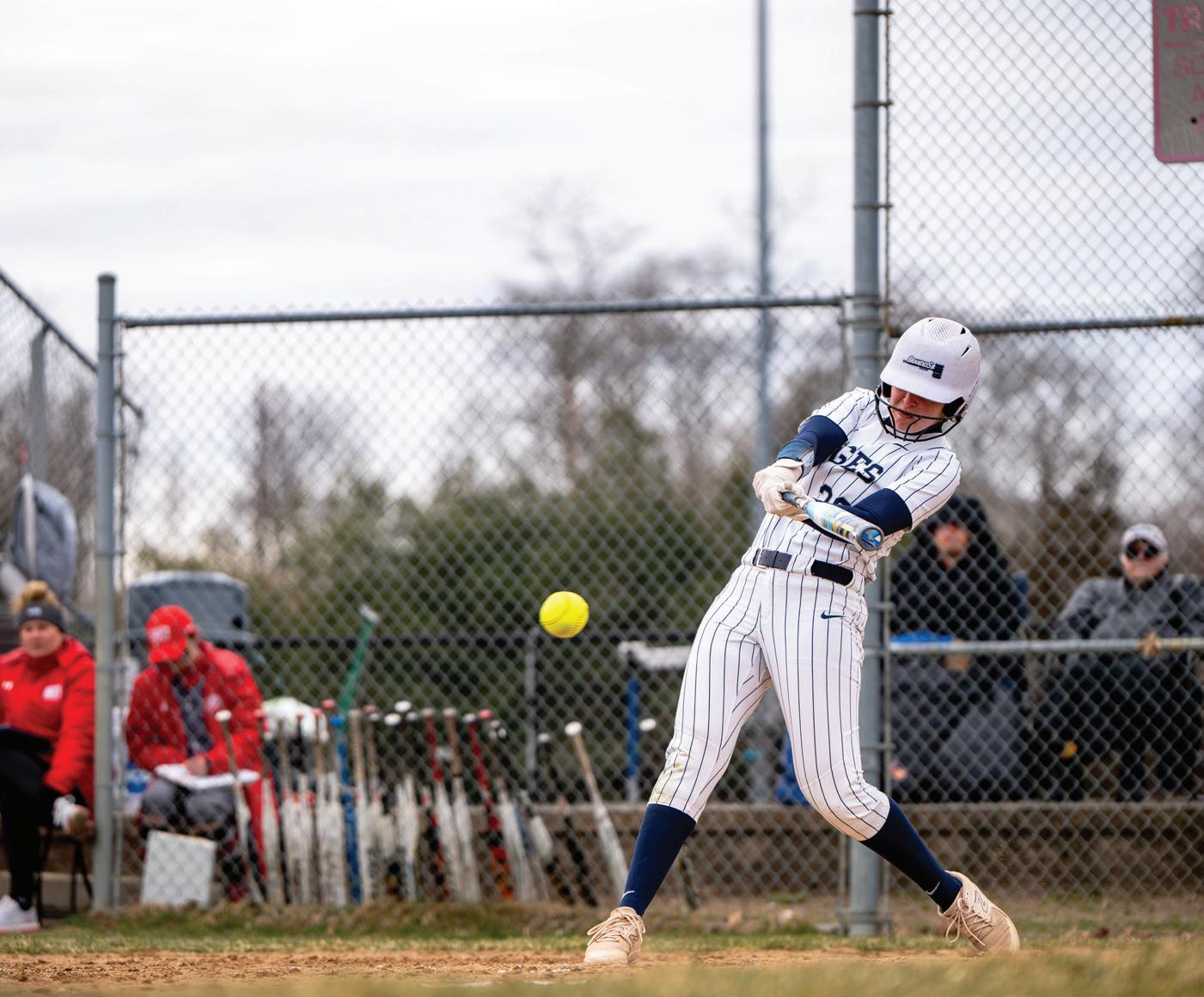

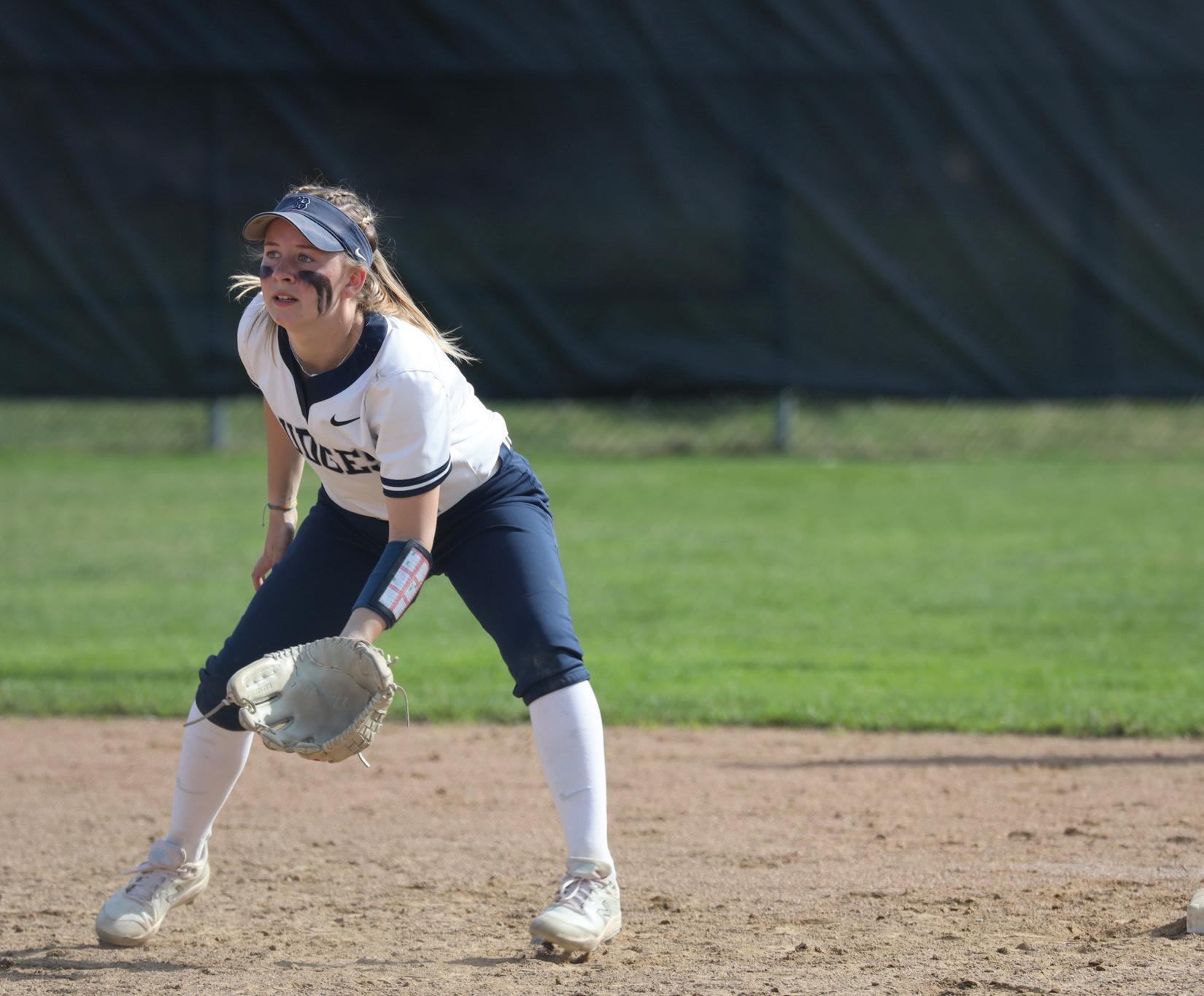
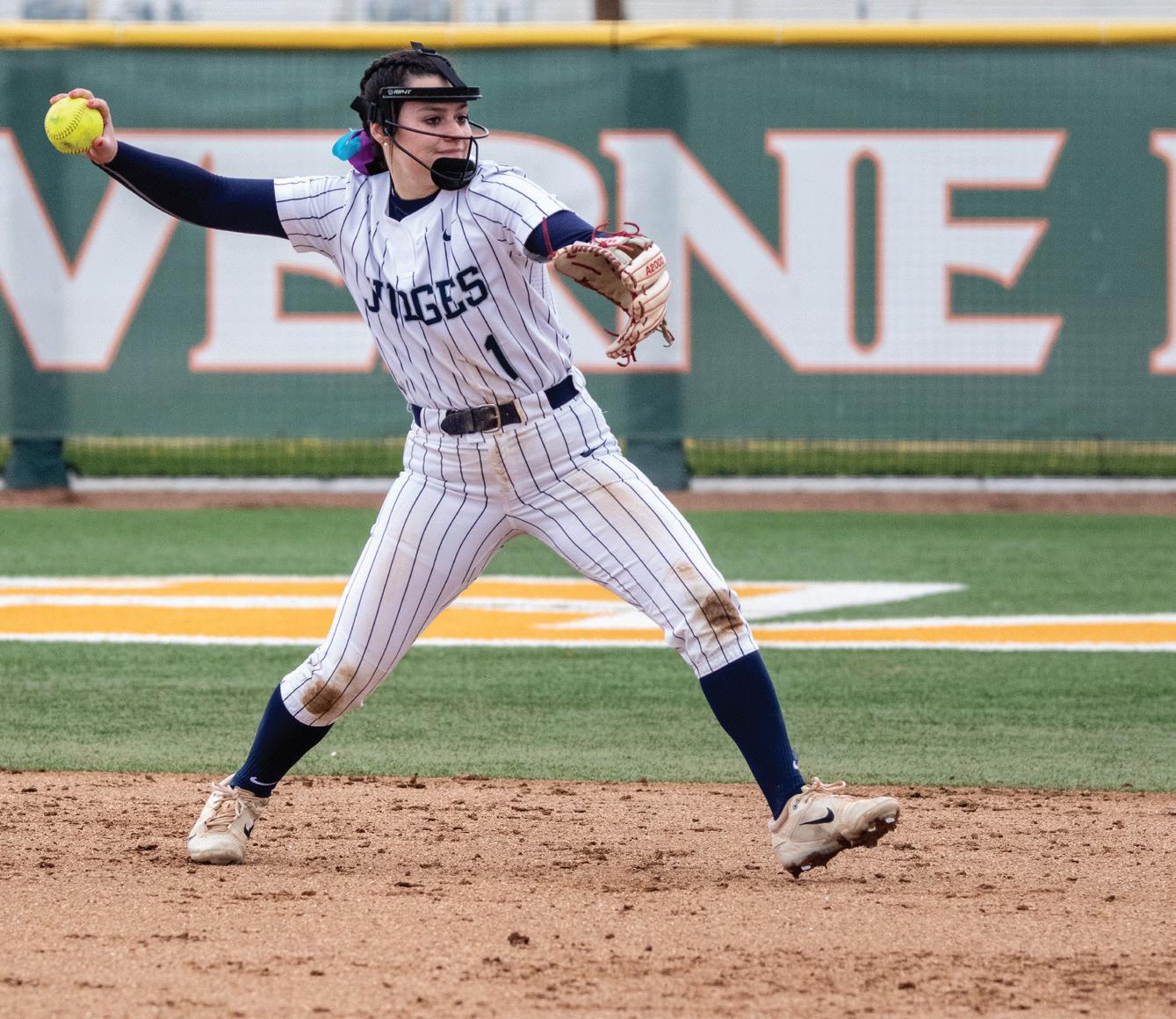
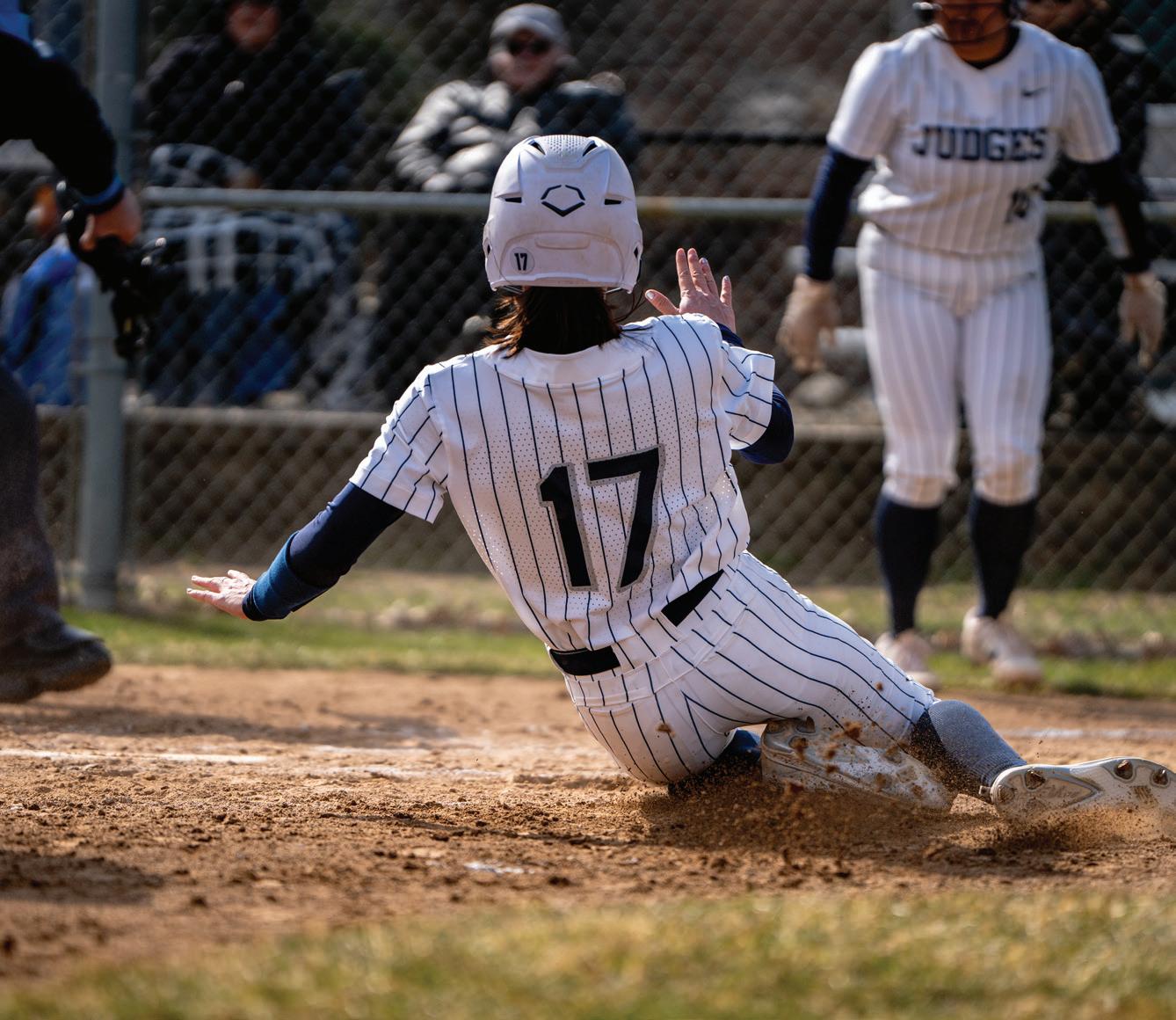
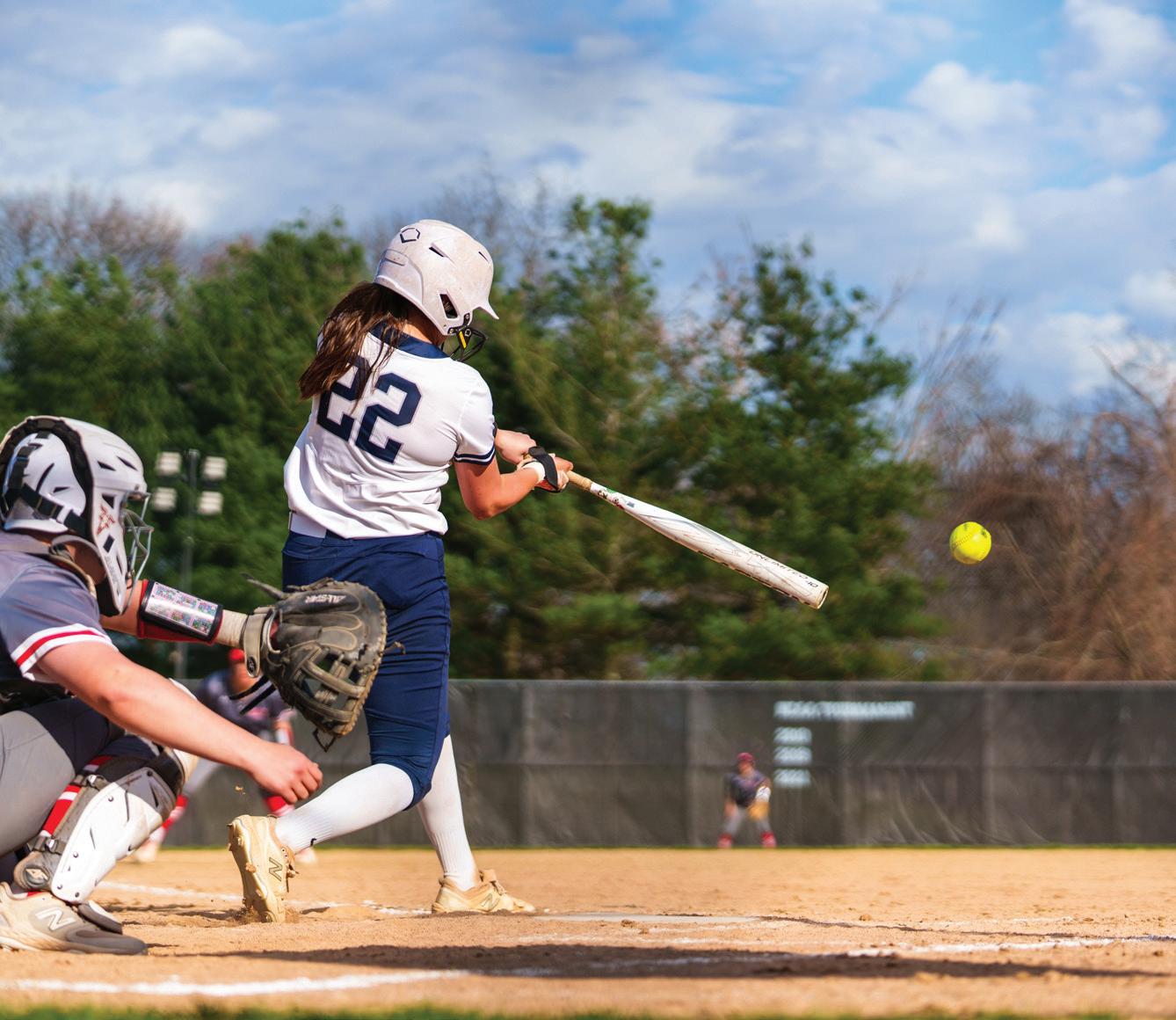
■ With the end of the season a little more than a month away, The Justice offers predictions for the contending teams that may be featured in this season’s playoff games.
By SOPHIA DE LISI JUSTICE DEPUTY EDITOR
Following the conclusion of the regular National Basketball League on April 13, the SoFi Play-In Tournament will take place between April 15 and April 18, the first playoff game taking place the day after.
Teams that finished between the seventh and tenth standings during the regular season enter the Play-In Tournament to face off for the seventh and eight playoff seeds. Although the regular season is still underway, it is still possible to make informed predictions about the contending teams, the tournament’s results and the 16 teams that will face off in the following playoff games.
The Entertainment and Sports Programming Network's analytics team launched a Basketball Power Index in 2015. The index is “meant to be the best predictor of a team’s performance for the rest of the season.” The BPI accounts for factors such as game-bygame efficiency, strength of schedule, days of rest, game location and preseason expectations. ESPN then uses each team’s BPI to make predictions about their chances of making the playoffs, Play-In Tournament, Conference Semifinals, Conference Finals and the NBA Finals.
Teams with a 100% chance of reaching the playoffs based on their BPI scores include: the Boston Celtics, the Cleveland Cavaliers, the Los Angeles Lakers, the New York Knicks, the Oklahoma City Thunder and the Milwaukee Bucks. According to ESPN’s Oct. 21, 2025 NBA season preview, the Boston Celtics had a 99.9% chance of reaching the playoffs from the start of the season. Concurrently, this season preview estimated the Oklahoma City Thunder would have a 97.3% chance, the Cleveland Cavaliers would have a 96.3% chance, the Los Angeles Lakers 56.1%, the New York Knicks with 64.6% and the Milwaukee Bucks with 93.4%. As of press time, these predictions stand the test of time.
Other teams with a high chance of entering the playoffs per their BPI are the Indiana Pacers, the Denver Nuggets, the Detroit Pistons, the Houston Rockets, the Memphis Grizzlies and the Golden State Warriors. Each of these teams have more than a 90% chance of reaching the playoffs. In comparison, the pre-season preview evaluated that the Denver Nuggets would have an 81.6% chance, the Mil -
waukee Bucks a 93.4% chance, the Grizzlies with 69.3%, the Pacers with a 69% possibility, the Golden State Warriors with 47%, the Houston Rockets 49.6% and the Pistons 2.1%.
Columbia Broadcast System Sports points to a “storm brewing” in the Western Conference between leading teams the Thunder, the Lakers, the Nuggets, the Grizzlies and the Rockets. Although the Oklahoma City Thunder are the favorite to win the conference, CBS explains that “underneath them the power structure is shifting rapidly,” CBS explains, meaning their position could prove precarious. The Grizzlies and Rockets started and maintained the season adeptly, but are hastily falling to the Lakers and the Golden State Warriors.
CBS suggests that these California teams’ sudden advancements come as a result of their star trade deadline acquisitions. In early February, the three-team trade that sent Luka Doncic to the Lakers and Anthony Davis to the Mavericks was a “blockbuster trade that figures to impact the Western Conference balance of power for years to come,” ESPN writes. Another CBS article highlights that the Lakers’ acquisition of Doncic reinvigorated LeBron James, relieving him of playmaking responsibilities and allowing him to take a break from his offensive possessions.
The Golden State Warriors’ addition of Jimmy Butler also helped improve their prospects for playoffs and the remainder of the regular season. Just as Doncic and James compliment one another as “co-stars” on the court, Butler has also proven himself a valuable offensive aid to Stephen Curry. CBS explains that Butler’s “playmaking and ability to get to the free-throw line gives the Warriors a source of uncomplicated offense,” and his competence has taken pressure off of Curry. In his relief, Curry’s performances have improved significantly, allowing him to successfully sink a dunk for the first time in six years on Mar. 1, for instance.
The trade acquisitions of Doncic and Butler have created considerable competition beneath Oklahoma City Thunder’s leading example as several teams fight for the second seed in the playoffs. Meanwhile, the East Conference pits the Celtics against their closest challengers, the Knicks and the Cavaliers. Last year, the Celtics won the NBA championship — if their season unfolds as planned, they will secure their 19th championship title.
The rosters for the NBA playoffs will be set on April 14, and ESPN’s standings and projections will be updating continuously in the meantime.

The Justice Editor in chief, Anna Martin '26, investigates the use of robots and artificial intelligence in refereeing pg. 11.
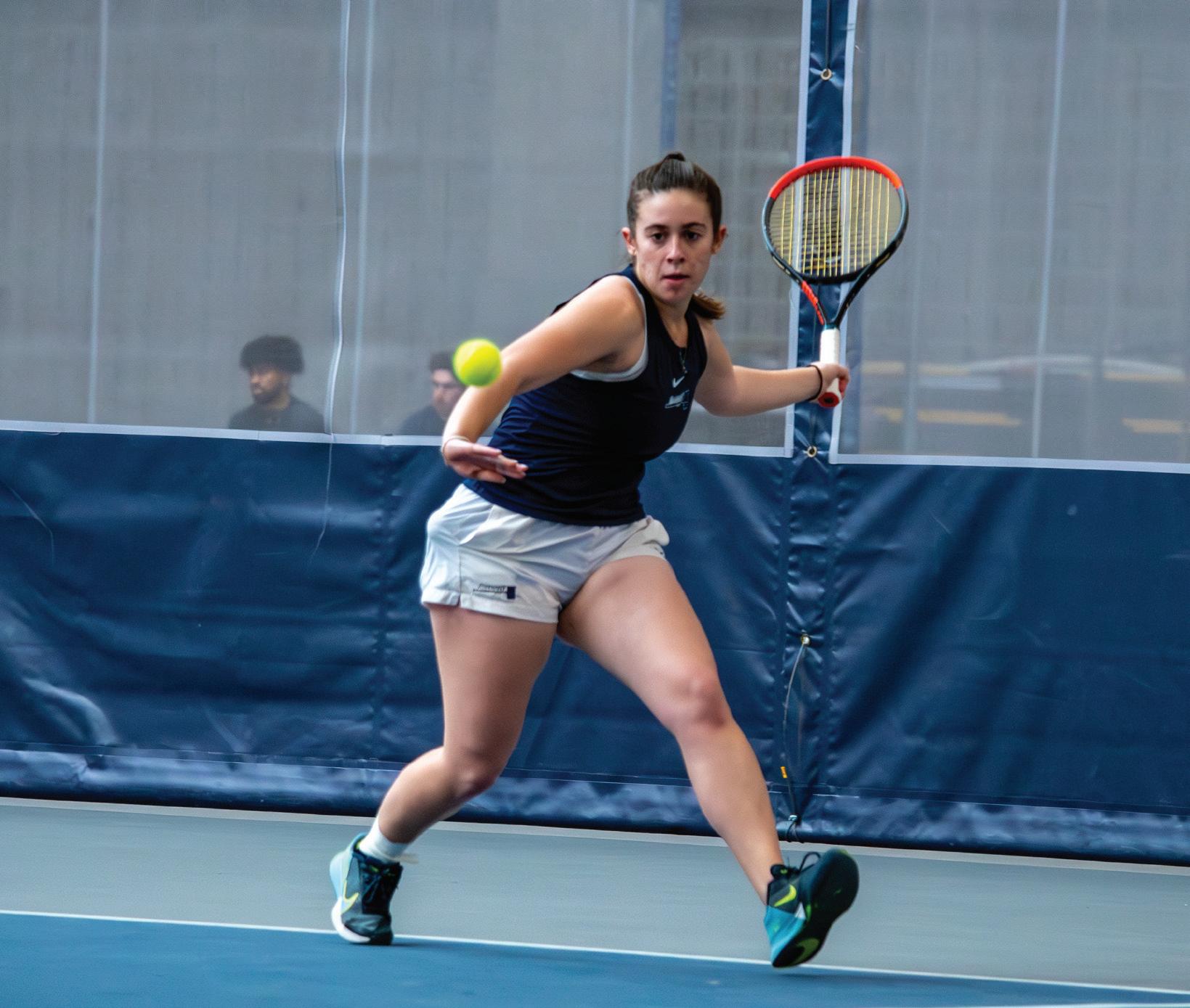
■ The Brandeis University men’s and women’s tennis teams played hard in their matches over the weekend, despite mixed results.
By REMI YOUNG JUSTICE EDITORIAL ASSISTANT
The Brandeis University tennis teams had a busy weekend on the court, showcasing their grit and determination. The men’s team picked up a decisive win against Nichols College, while the women’s team was narrowly defeated by their ranked rivals, Babson College.
The men’s tennis team won their third consecutive victory. They are on the road to improve their season record to 3-3 after defeating Nichols College 6-1.
The Judges clinched the match early on with a dominant performance across the singles and doubles courts.
Doubles Play
On the doubles side, Brandeis experienced a strong start, winning the first of two matches. The number one doubles team of Dylan Walters MA ’25 and Daniel Shemesh ’28 secured a 6-2 win.
Singles Action
Brandeis extended their advantage in their singles matches with straight-set wins in the top three positions. Walters was first to finish, securing a 6-3, 6-4 victory in the number one spot. Walters’ win was followed by an outstanding performance from Shemesh ’28, who cruised to a 6-1, 6-0 victory at number two singles.
The clinching point came
from Pierce Garbett ’27, who battled through a tight first set, ultimately winning a tiebreaker 7-4, then closed out the match 6-3 in the second set. This performance was a testament to the mental toughness present throughout this team.
Huasen Dong ’27 also made his mark, winning 6-3, 6-0 at the number five position to extend the Judges’ lead to 5-0. The only point for Nichols came at number four singles, where Benjamin Kotzen ’28 went down 6-1, 6-3. However, Kotzen also played number six singles, securing a hard-fought 5-7, 7-6 (7-5), 10-2 victory to give Brandeis the 6-1 win.
Next, Brandeis will face its rival, New York University, on Sunday, March 16, at 1 p.m.
The 25th-ranked Brandeis women’s tennis team faced off against number 17 Babson College in their home opener at the Gosman Sports and Convocation Center. Despite the Judges’ best efforts, the Beavers ultimately clinched a tight 4-3 win.
Doubles Play
Brandeis started the match on a strong note in doubles action. The Judges’ number three doubles team, composed of Cecilia Denis ’25 and Anastasia Sia ’25, came out on top with a 6-2 victory. However, when moving to the other doubles courts, the team struggled.
At number one doubles, Babson’s top duo, Olivia Soffer ’25 and Matia Cristiani ’26, the reigning National Collegiate Athletic Association Division III champions, faced off against Brandeis' Bhakti Parwani ’25 and Rebecca Suarez ’26. The match was close, with serving playing a key role early in the set. Ultimately, Babson’s Soffer and Cristiani took the game 6-4. At number two doubles, Chahana Budhbhatti ’27 and Nancy Zhang ’26 were also involved
in a tight contest. After a backand-forth battle, the sisters of Babson's top duo, Chaniel Soffer ‘27 and Alessandra Cristiani ‘28, managed to pull off the win in the final games, winning 7-5 to give the Beavers a 1-0 lead as singles play began.
In singles action, Parwani fell 6-2, 6-1 to Babson’s Matia Cristiani, but Brandeis wasn’t ready to give up. At the number one position, Suarez won in a close 7-5, 6-4 match. This victory cut the Beavers’ lead to 2-1. Next, Zhang fell 6-3, 6-0 at the #4 singles position, putting Babson within one point of victory. To extend the match, Sia delivered a dominant 6-3, 6-1 win at number five singles to put Babson ahead by just one game, at 3-2 for the day.
The deciding match of the day came at #3 singles, where Brandeis’ Budhbhatti faced off against Babson’s Chaniel Soffer in two long matches that lasted nearly three hours. Budhbhatti kept fighting after losing the first set in a tiebreaker, returning to win the second set 6-4. In the third set, Soffer clinched the victory for Babson with a 7-6 (70), 4-6, 6-2 win.
Brandeis’ Charly Saltz ’28 earned a 6-3, 6-1 win at number six singles, but by then, the result had already been decided, with Babson securing a 4-3 victory.
The Brandeis women’s team will travel to Colby College next Sunday, March 16, for a 2 p.m. match.
Both Brandeis tennis teams showcased tremendous talent and determination in their recent matches, with the men’s team earning a solid victory and the women’s team falling just short against Babson College. Both teams look to use this momentum next weekend in their next matches.
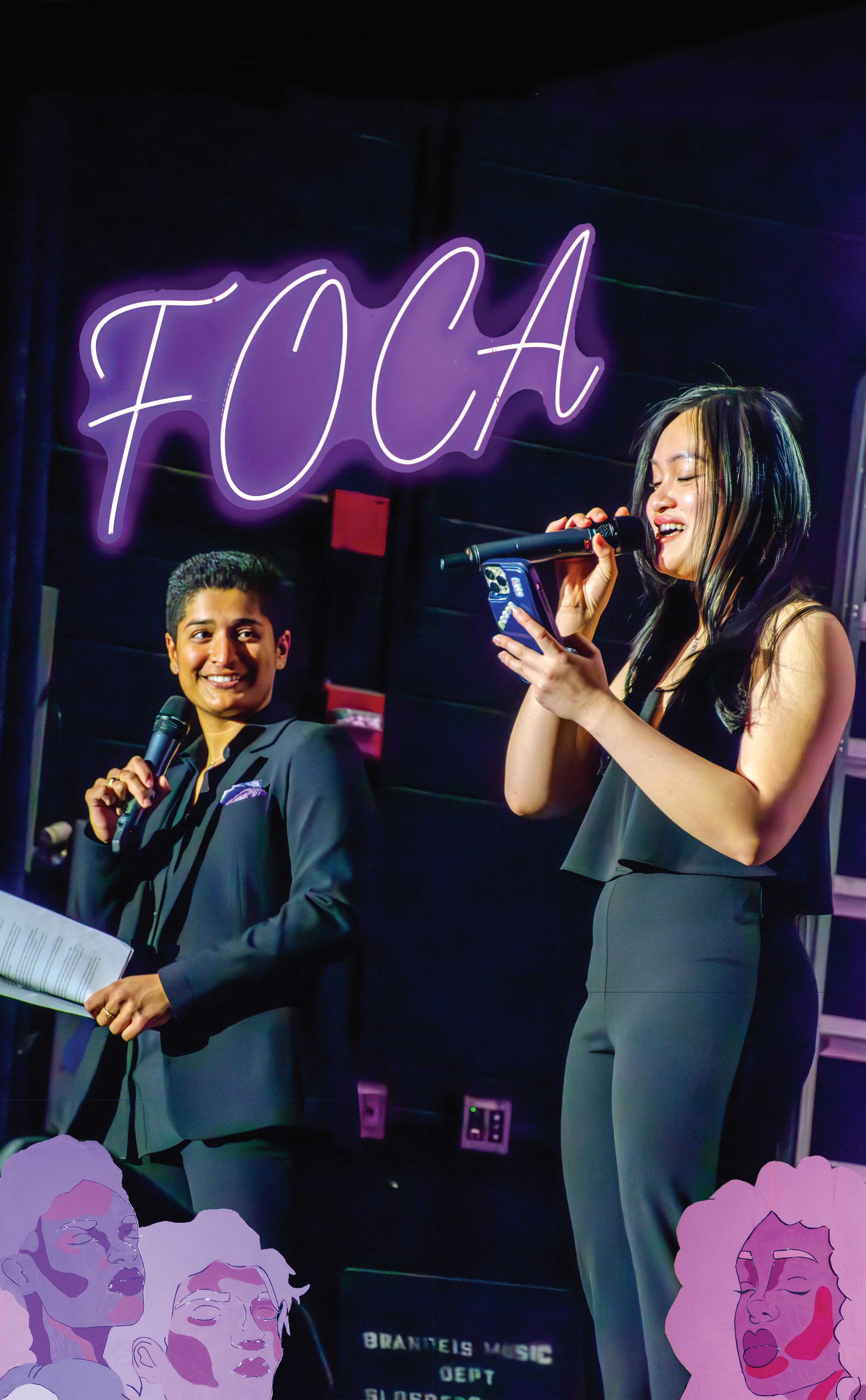
By NEMMA KALRA JUSTICE EDITOR

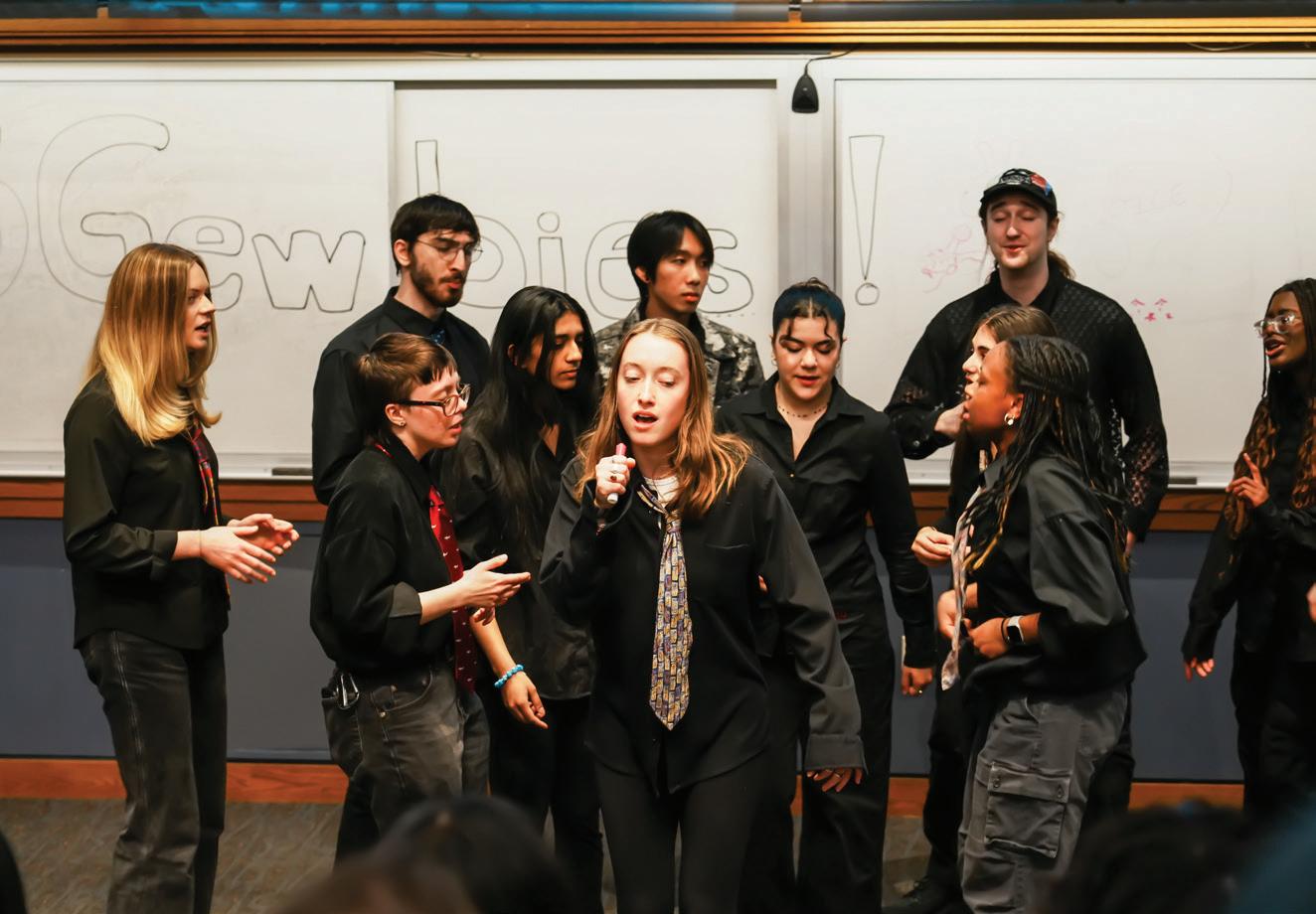
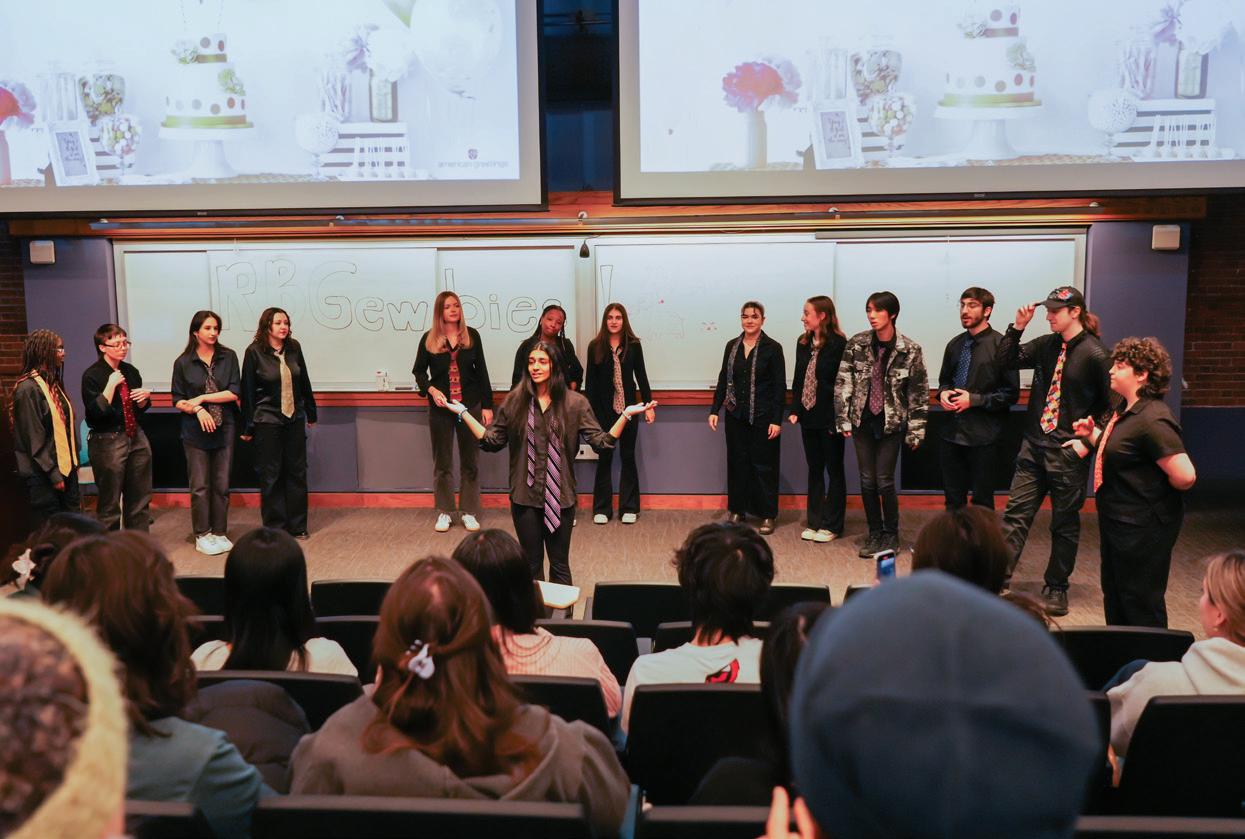
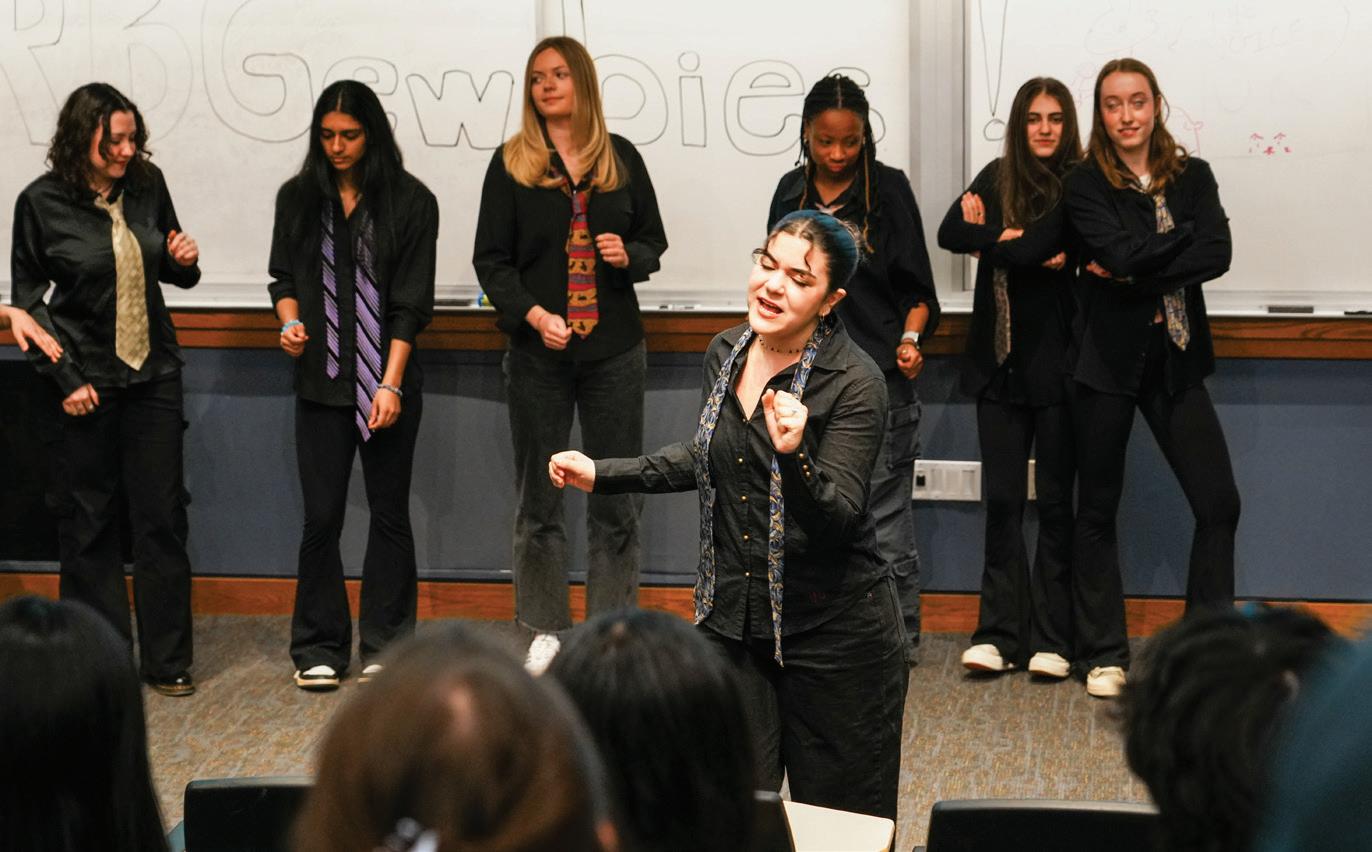
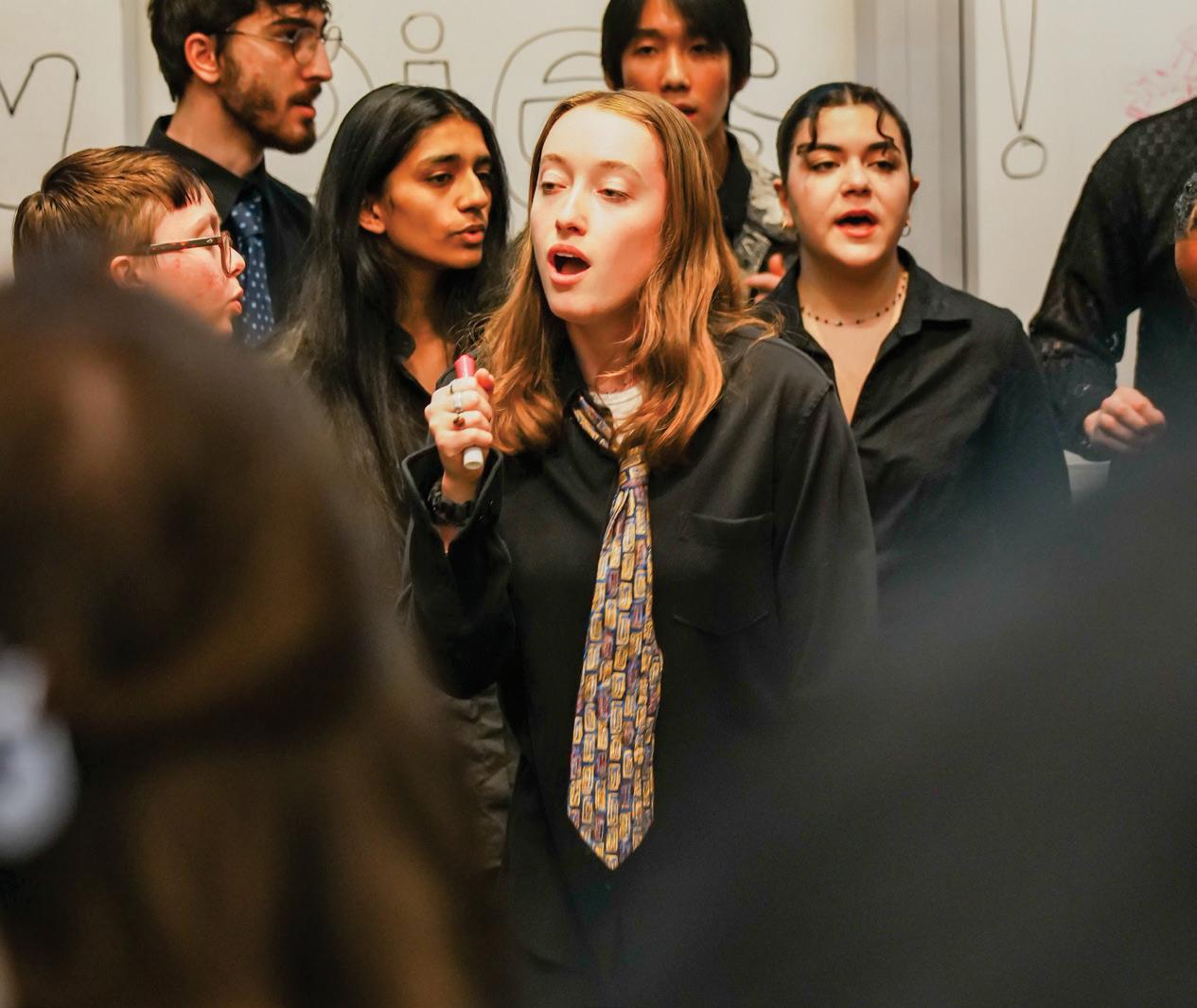
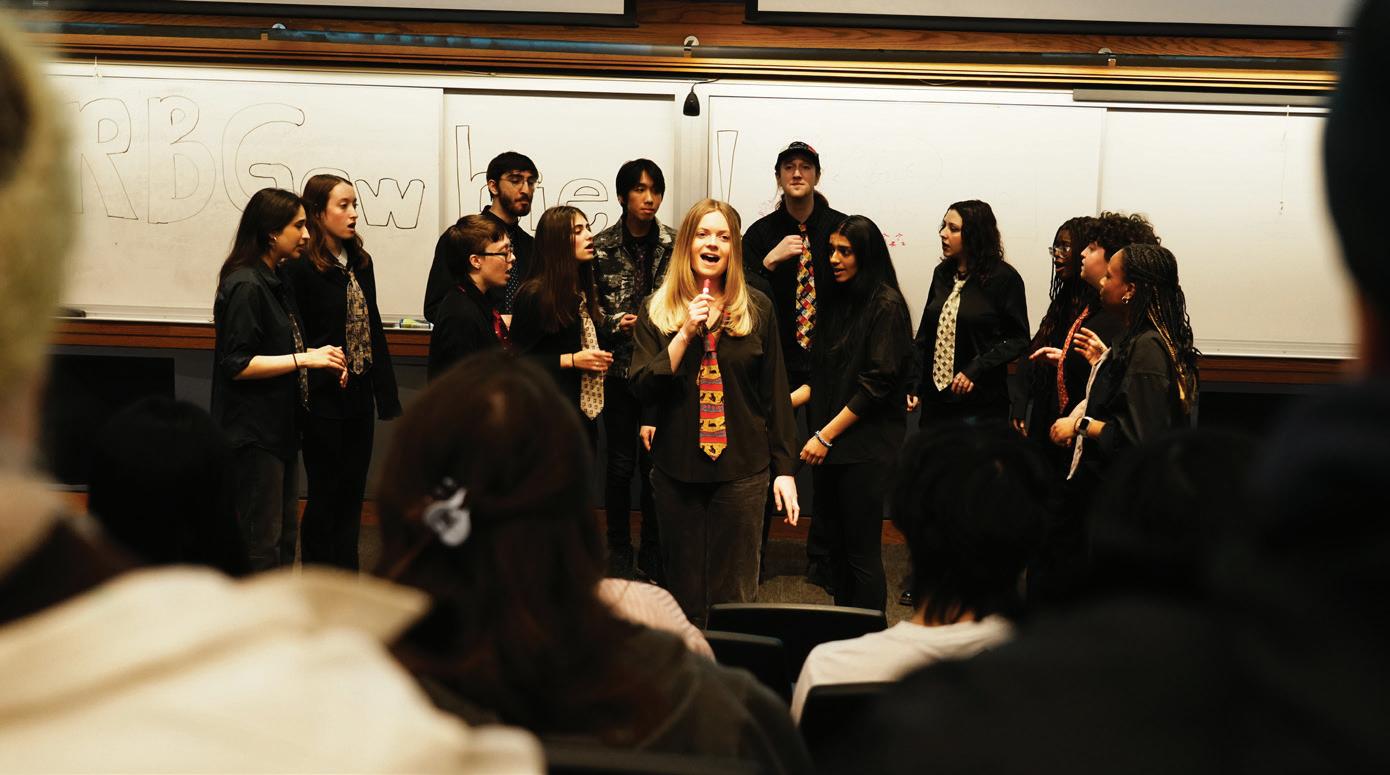
By MIKEY TERRENZI JUSTICE OVERSEAS STAFF WRITER
In March of this year, the permanent collection of the Musée National d’art Moderne — the National Modern Art Museum — of Paris closed its doors for five years. Consecrated as the Centre Georges Pompidou, this modern art museum has housed a large collection of avant-garde art from the early 20th century since 1977. The Pompidou center represents the history of the avant-garde in Paris and the promulgation of modern art as a national art form. Such a closing of a historic collection has been disheartening to say the least. Despite the varied personal opinions of modern art, there is no denying the historical impact of this art style as a social movement.
Oftentimes the closing of such cultural and educational institutions encourages us to speak about the local social impacts, yet here I would like to enlarge the frame. In the midst of a shared global conservative populist movement, President Donald Trump has recently slashed grants for the National Endowment for the Arts. Whether there is disagreement on the motives for such economic decisions, the fact remains that the institutions meant to preserve educational and cultural involvement in the United States are suffering in the occidental wave to the right. I would like to explore the recent actions of Trump and the closing of the National Modern Art Museum of France in conversation with one another.
The closing of the National Modern Art Museum of France has been discussed at length in anglophone and francophone publications. In review, the museum and its component parties such as the Bibliothèque publique d’information, the National Library, will be closed until 2030 to remove asbestos and remodel the museum. This closure has caused some outrage in Paris, calling for the renovations to be reconsidered. The Centre Pompidou serves the Parisian community on a daily basis, offering an educational space that provides public access without inscription, identification and fee. I believe such an environment should not be closed to the public during such global conflict. Similarly, the history of the Centre Pompidou speaks to the preservation of the avant-garde. The avant-garde artists of France often spoke out against fascism, racism and sexism. While there exist notable exceptions to such a statement, the surrealists, dadaists and fauvists all shared anti-authoritarian ideologies that encouraged a populist perception of art. In this context we see how such a closing of this museum speaks to an actual reduction of such arts.
Moving towards the reduction of art, in January and February the Trump administration slashed funding and grants for people of color and LGBTQ+ artists as a part of the National Endowment for the Arts. The National Endowment of the Arts was established in 1965 by President Lyndon B. Johnson’s administration as a part of a national movement to increase artistic excellence in the U.S. Since its establishment, the NEA has given grants, fellowships and jobs to artists through federal funding. Of course, there have been previous controversies involving several artists, such as Robert Mapplethorpe and Andres Serrano in the 80s, which have called into question the funding of the NEA. Despite such controversy, the federal office has withstood time and will celebrate its 60th anniversary this year. However, Trump’s executive orders on Diversity, Equity and Inclusion, as well as “gender ideology” have threatened artists who rely on grants from the NEA. For example, The Art Museum of Americas has canceled exhibitions of Black artists from the Americas.
Unfortunately, this is not a new pattern of federal funding and the arts have been suf -
COMMUNITY CONVERSATION
fering nationally and globally from a disinterested political climate. I want to stress two effects I find troubling. The movements of modern art from the 19th century onwards were for the representation of the people. I recognize that may not have been every artist’s motive, but the interrogation of representation through not just subject but also aesthetic ideas places society in question. When the government reduces and rejects art, it also inherently excuses itself from its actions. This is the first effect I find difficult to accept. The Trump administration, yet more largely the trend of economic conservatism, is removing itself from the witness stand, pardoning itself from the public forum it is duty bound to serve.
My second concern addresses the art itself. Artists should represent a diversity, a multitude, a constellation of life experiences, identities, mediums and stories. An artist is not only someone who creates but someone whose work anchors itself in the moment it is conceived. Each piece of art is from that which it came and to that which it inspires. When we place restrictions on what is acceptable, art reduces itself. My concern involves the future as well. How will a future generation of artists create from such a restricted framework?
Artists will survive of course; it is our nature. I encourage you to go and create art, participate in the action of conceiving a piece. Experience the journey of distinguishing a singular moment of time in material work, expressing yourself and your past, guiding your future. There are people who aim to stop us from speaking, I encourage you to take to the chisel in defiance.

Following Saturday’s performance of “Intractable Woman” the Department of Theater Arts hosted a talk between investigative reporter Matthew Kupfer ’12 and Russian journalist Elena Kostyuchenko titled “The Legacy of Anna Politkovskaya and Journalism Today.” It would be remiss not to mention that Kupfer has extensive experience covering stories in Eastern Europe and the United States at the global and local levels. Both Kostyuchenko and Kupfer asked each other questions and answered inquiries from the audience.
The event was open to the public and was thematically aligned with “Intractable Woman’s” subject matter, Russian journalist Anna Politkovskaya. Politkovskaya was internationally renowned for her investigative reporting work on the Second Chechen War, the subject of the play. Unfortunately, Politkovskaya was killed in the elevator of her apartment building in Moscow in 2006, a crime which many still believe to be unsolved.
Kupfer and Kostyuchenko began their conversation discussing Politkovskaya and the way Russian journalism has changed in the wake of her death. Kostyuchenko previously worked at Novaya Gazeta where she briefly overlapped with Politkovskaya. However, in 2022 the Novaya Gazeta’s journalistic license was revoked by Roskomnadzor, Russia’s federal agency that oversees censorship of Russian mass media, for their coverage of
By MAEVE COAKLEY JUSTICE EDITORIAL ASSISTANT
Russia’s invasion of Ukraine. Officially, the Novaya Gazeta no longer exists and Kostyuchenko now lives in exile.
After discussing Russia’s censorship of journalism following their invasion in Ukraine Kostyuchenko asked Kupfer about the challenges journalism is currently facing in America. Jeff Bezos’ recent interventions in dictating what The Washington Post publishes were mentioned as an example. Kupfer’s response was to highlight America’s strong tradition of free press and that it was too early and hard to say whether journalists were prepared for what may be deemed as further censorship. He stressed that the approach of journalism does not change and that his personal belief is the risk lies in how the press will choose to interrogate the current administration. The press must walk the fine line between “too much advocacy” and “too much obfuscating.” He also said that he thinks it is best to wait and see how things change as the early surprises of the new administration wear off. Kupfer and Kostyuchenko then took questions from the crowd on a variety of subjects. They ended with discussing bipartisanship and how to talk with family members with very different political views. Ultimately they concluded by saying that understanding and connecting with others is important because we must coexist with one another.
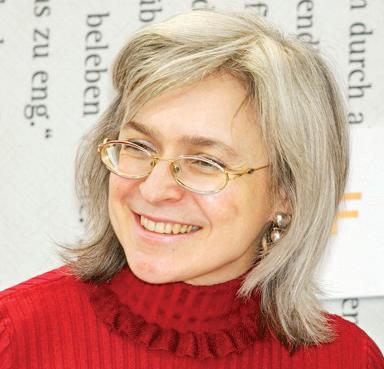
TUESDAY,
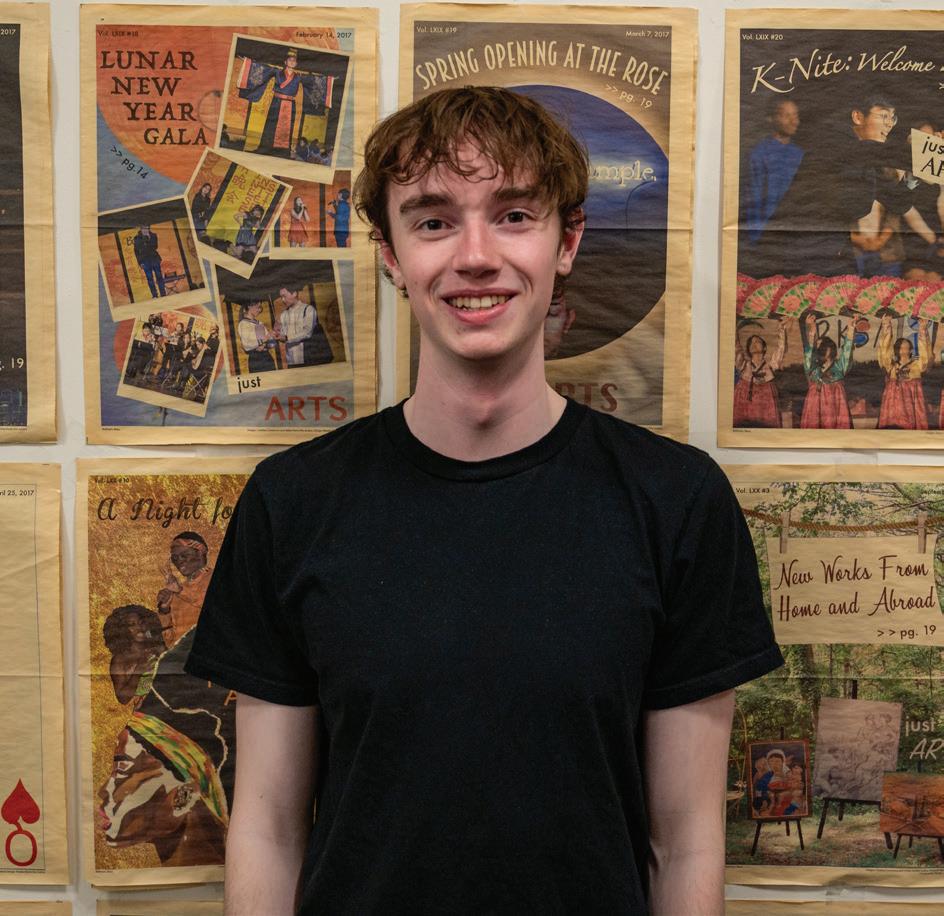
1. “Locked Out Of Heaven”
2. “Marry You”
3. “Just The Way You Are”
4. “Grenade”
5. “Leave The Door Open”
6. “That’s What I Like”
7. “Talking To The Moon”
8. “Count On Me”
9. “24k Magic”
10. “Billionaire”


